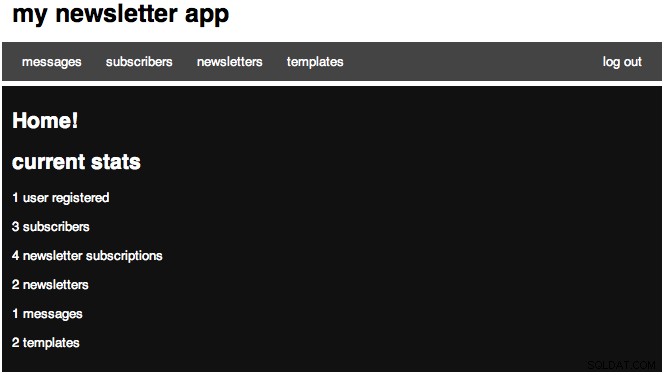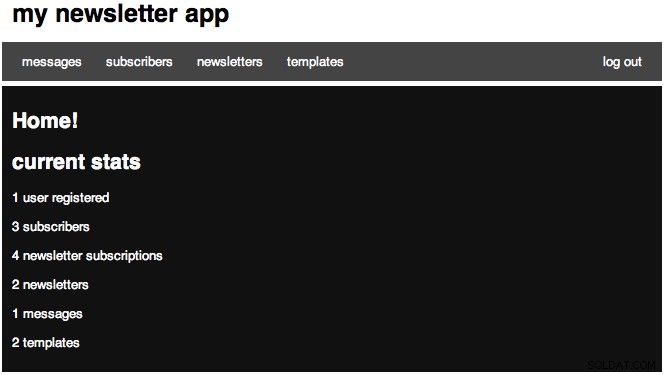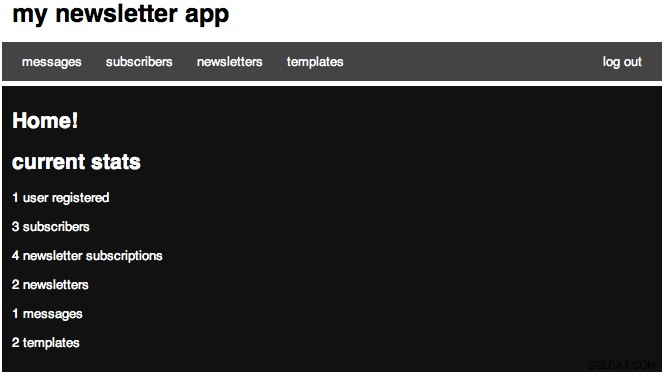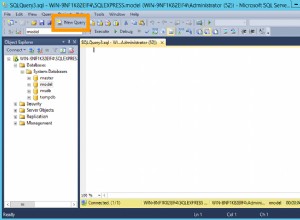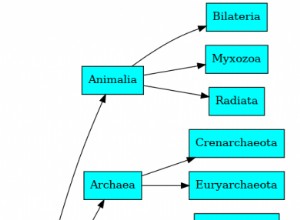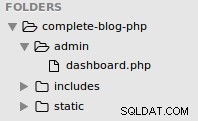Hoje, vamos construir um sistema de newsletter usando PHP com base em MySQL. O tutorial cobrirá a construção de um sistema que permite várias listas de newsletters e o envio de mensagens para listas específicas.
Ei pessoal, vamos construir um sistema de newsletter bastante complexo, então vamos começar! Você vai precisar de dois recursos para o projeto.
- O conjunto Silk Icon será usado para adicionar um toque visual ao aplicativo.
- O Swift PHP Mailer será usado para enviar nossos e-mails.
Etapa 1:criar o esqueleto do aplicativo
Ao iniciar qualquer projeto, gosto de fazer o layout das pastas antes de começar a codificar, então vamos fazer isso agora. Primeiro, crie o diretório geral do projeto. Em seguida, crie uma pasta chamada admin dentro da pasta do seu projeto. Em seguida, dentro da pasta admin, adicione dois nomes de pastas media e swift. Por fim, crie uma pasta chamada imagens dentro do diretório de mídia. Além disso, você pode colocar a pasta Swift lib dentro da pasta swift que criamos. Você também pode copiar os seis ícones de silks que usaremos:
- bullet_green.png
- bullet_red.png
- excluir.png
- email_go.png
- encontrar.png
- page_edit.png
Vou estruturar o restante do tutorial sobre como criar o CRUD:criar, ler, atualizar e excluir para quatro de nossos seis modelos. Uma outra será editada por outras ações, e a sexta não estaremos criando as ações CRUD.
Agora vamos primeiro criar nosso banco de dados, e nossas tabelas serão criadas progressivamente depois. Agora vamos começar a codificar. Além disso, como uma observação, assumirei que trabalharemos com arquivos em nossa pasta admin, a menos que eu especifique de outra forma, pois a maior parte do código está nessa pasta.
Etapa 2:configuração do aplicativo
Todo aplicativo terá algum tipo de arquivo de configuração, e vamos criar o nosso agora. Vá em frente e crie um arquivo chamado config.php e adicione o seguinte:
# admin/config.php
<?php
// DB Settings
define('DB_SERVER', 'localhost');
define('DB_USER', 'root');
define('DB_PASSWORD', '');
define('DB_NAME', 'nettuts_ns_demo');
define('FROM_EMAIL', '[email protected]');
define('FROM_NAME', 'oh yeah email!');
session_start();
require_once 'classes.php';
$mini = false;
$nonav = false;
error_reporting(0); Portanto, a primeira seção configura nossas variáveis de banco de dados, portanto, certifique-se de editá-lo para que seja o primeiro a sua configuração local. Nossa próxima sinopse configura alguns atributos de e-mail que usaremos mais tarde. A última seção inicia nossa sessão para que possamos acessá-la, requer nosso arquivo classes.php (nós o criaremos em apenas um segundo), define os padrões para algumas opções de layout e, em seguida, define o relatório de erros como 0 para parar de avisos irritantes . No entanto, se você parece estar tendo problemas, tente comentar esta linha.
Agora vá em frente e crie nosso arquivo classes.php e adicione:
# admin/classes.php
<?php
// Authentication
function validate_user($username, $pw) {
if (check_username_and_pw($username, $pw)) {
header('Location: index.php');
} else {
$_SESSION['error'] = "Login error.";
header('Location: login.php');
}
}
function logged_in() {
if ($_SESSION['authorized'] == true) {
return true;
} else {
return false;
}
}
function login_required() {
if(logged_in()) {
return true;
} else {
header('Location: login.php');
}
}
// mysql
function query($sql) {
$link = new mysqli(DB_SERVER, DB_USER, DB_PASSWORD, DB_NAME) or die('There was a problem connecting to the database.');
$stmt = $link->prepare($sql) or die('error');
$stmt->execute();
$meta = $stmt->result_metadata();
while ($field = $meta->fetch_field()) {
$parameters[] = &$row[$field->name];
}
$results = array();
call_user_func_array(array($stmt, 'bind_result'), $parameters);
while ($stmt->fetch()) {
foreach($row as $key => $val) {
$x[$key] = $val;
}
$results[] = $x;
}
return $results;
$results->close();
$link->close();
}
function count_query($query) {
$link = new mysqli(DB_SERVER, DB_USER, DB_PASSWORD, DB_NAME) or die('There was a problem connecting to the database.');
if($stmt = $link->prepare($query)) {
$stmt->execute();
$stmt->bind_result($result);
$stmt->fetch();
return $result;
$stmt->close();
}
$link->close();
}
function check_username_and_pw($u, $pw) {
$link = new mysqli(DB_SERVER, DB_USER, DB_PASSWORD, DB_NAME) or die('There was a problem connecting to the database.');
$query = "SELECT * FROM users WHERE username = ? AND password = ? LIMIT 1";
if($stmt = $link->prepare($query)) {
$p = md5($pw);
$stmt->bind_param('ss', $u, $p);
$stmt->execute();
$stmt->bind_result($id, $username, $pw);
if($stmt->fetch()) {
$_SESSION['authorized'] = true;
$_SESSION['username'] = $username;
return true;
} else {
return false;
}
$stmt->close();
}
$link->close();
} Isso é um pedaço enorme de código, e eu vou passar por isso. Nossa primeira função lida quando o usuário publica nosso login e, em seguida, envia os dados para nossa função check_username_and_pw. Nossa função login_in simplesmente retorna se um usuário está logado. Nossa função login_required verifica se estamos logados e, caso contrário, nos envia para a página de login.
A próxima função simplesmente chamada query() executa uma consulta em nosso banco de dados e foi criada por Jeffrey Way. Adicionei as funções de criação e fechamento de links para facilitar ainda mais. Nossa próxima função que criei especialmente para que possamos executar facilmente COUNT consultas SQL, e nossa função check_username_and_pw verifica se podemos encontrar um usuário com o mesmo email e senha com hash MD5 e, em caso afirmativo, define nossas variáveis de sessão.
Etapa 3:Layout do aplicativo
Nosso próximo arquivo em que trabalharemos é nosso arquivo layout.php, então vá em frente e crie-o. Em nossa seção head, simplesmente declaramos nossas declarações XHTML regulares. Se você perceber, adicionamos automaticamente o título da página a outra string para o nosso título. Então temos uma folha de estilo (vá em frente e crie isso também em nossa pasta de mídia). Depois disso, abrimos nossa tag body e verificamos se queremos um mini layout e, em caso afirmativo, adicionamos uma classe. Em seguida, temos nosso cabeçalho e, em seguida, verificamos se queremos nossa navegação e, se quisermos, mostramos nossas guias. Eu também adicionei uma maneira de adicionar uma classe atual para cada guia. Também temos um link de logout e, em seguida, nosso div de contêiner. Nele, adicionamos uma tag h3 com nosso título e, em seguida, ecoamos nosso conteúdo.
# admin/layout.php
<!DOCTYPE html PUBLIC "-//W3C//DTD XHTML 1.1//EN" "http://www.w3.org/TR/xhtml11/DTD/xhtml11.dtd">
<html xmlns="http://www.w3.org/1999/xhtml" >
<head>
<meta http-equiv="Content-Type" content="text/html; charset=utf-8" />
<title><?php echo $title; ?> » my newsletter app</title>
<!-- Stylesheets -->
<!-- <link rel="stylesheet" href="media/style.css" type="text/css" media="all" /> -->
</head>
<body<?php if ($mini == true) { ?> class="mini"<?php } ?>>
<div id="header">
<h1><a href="index.php">my newsletter app</a></h1>
</div>
<?php if ($nonav == false) { ?>
<div id="nav">
<a href="messages.php"<?php if($tab == 'mess') {?>class="current"<?php } ?>>messages</a>
<a href="subscribers.php"<?php if($tab == 'sub') {?>class="current"<?php } ?>>subscribers</a>
<a href="newsletters.php"<?php if($tab == 'nl') {?>class="current"<?php } ?>>newsletters</a>
<a href="templates.php"<?php if($tab == 'temp') {?>class="current"<?php } ?>>templates</a>
<span class="right">
<a href="logout.php">log out</a>
</span>
</div>
<?php } ?>
<div id="container">
<h3><?php echo $title;?></h3>
<?php echo $content; ?>
</div>
</body>
</html> Agora, vamos criar nossa página index.php apenas para que possamos estilizar. Abra index.php e adicione:
# admin/index.php <?php require_once 'config.php'; $title = "Home!"; $content = <<<EOF <h3>current stats</h3> Our home page! EOF; include 'layout.php'; ?>
Então, neste, nós exigimos nosso arquivo de configuração, configuramos nosso título e, em seguida, configuramos nossa variável de conteúdo e, por último, nosso arquivo de layout. Ao abri-lo pela primeira vez, ele deve se parecer com:
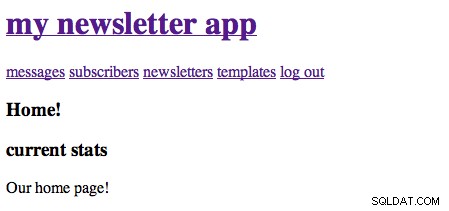

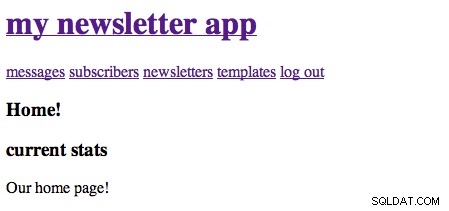
Agora abra nossa folha de estilo. Gosto de usar os estilos de reset e tipografia 960.gs, compactados no TextMate. Então, o topo do meu arquivo CSS se parece com:
# admin/media/style.css
/* reset */
html,body,div,span,applet,object,iframe,h1,h2,h3,h4,h5,h6,p,blockquote,pre,a,abbr,acronym,address,big,cite,code,del,dfn,em,font,img,ins,kbd,q,s,samp,strike,strong,sub,sup,tt,var,b,u,i,center,dl,dt,dd,ol,ul,li,fieldset,form,label,legend,table,caption,tbody,tfoot,thead,tr,th,td{margin:0;padding:0;border:0;outline:0;font-size:100%;vertical-align:baseline;background:transparent}body{line-height:1}ol,ul{list-style:none}blockquote,q{quotes:none}blockquote:before,blockquote:after,q:before,q:after{content:'';content:none}:focus{outline:0}ins{text-decoration:none}del{text-decoration:line-through}table{border-collapse:collapse;border-spacing:0}
/* typography */
body{font:13px/1.5 Helvetica,Arial,'Liberation Sans',FreeSans,sans-serif}a:focus{outline:1px dotted invert}hr{border:0 #ccc solid;border-top-width:1px;clear:both;height:0}h1{font-size:25px}h2{font-size:23px}h3{font-size:21px}h4{font-size:19px}h5{font-size:17px}h6{font-size:15px}ol{list-style:decimal}ul{list-style:square}li{margin-left:30px}p,dl,hr,h1,h2,h3,h4,h5,h6,ol,ul,pre,table,address,fieldset{margin:10px 0;} Vamos primeiro estilizar nossos elementos principais, então adicione os seguintes estilos:
# admin/media/style.css
#header {width:85%; margin:0 auto;}
#header h1 a {text-decoration:none; color:#000;}
#container {width:85%; background: #111; margin:5px auto; color:#fff; padding:10px;} Agora sua página deve ficar assim:



Agora, se estilizarmos as guias com um plano de fundo de navegação e, em seguida, um plano de fundo em cada um dos links, você deverá ver:
# admin/media/style.css
/* tabs */
#nav {margin:0 auto 2px;padding:10px;width:85%; background:#444;}
#nav a { padding:12px 10px; margin:0; color:#fff; text-decoration:none; text-align:center;}
#nav a.current, #nav a:hover {background:#111;}
#nav span.right {float:right;} 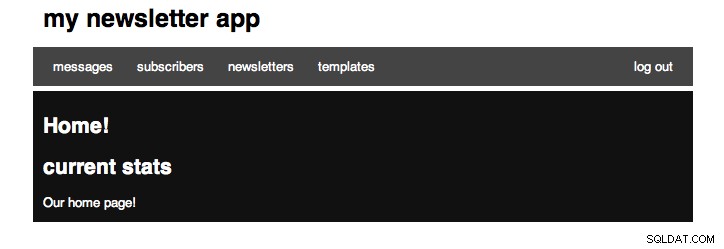
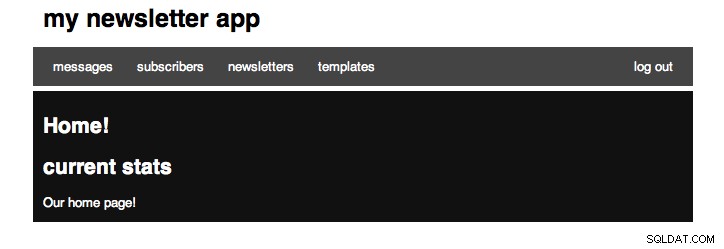
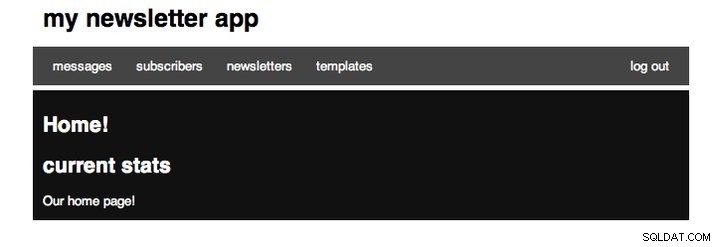
Agora, enquanto estamos trabalhando no arquivo, vá em frente e adicione os seguintes estilos para nosso mini layout, entradas de formulário, tabelas, links grandes e nossas mensagens de erro e sucesso.
# admin/media/style.css
body.mini #header {width:30%; text-align:center;}
body.mini #container {width:30%;}
/* form */
form input.text {width:95%; font-size:16px;}
form textarea {width:95%; height:100%;}
/* table */
table {width:98%; text-align:right; border:rgb(128,128,128); font-size:12px; margin:5px 10px; color:#000;background:#fff;}
table th {background-color: rgb(229, 229, 229); border:1px solid rgb(187, 187, 187); padding:3px 6px; font-weight:normal; color:#000;}
table tr td {border: 1px solid rgb(221, 221, 221); padding:3px 6px;}
table tr:hover {background-color: rgb(240, 240, 240);color:#000;}
/* a */
a.large {padding: 5px; color:#000; background:#eee; text-decoration:none; margin:5px;}
a.large.right {float:right;}
a.large:hover, a.large.current {background:#444; color:#fff;}
/* messages */
#message {margin: 5px 10px; padding: 4px; display:block;text-align:center;}
#message.error {background:#FFEBE8;border: 1px solid #CC0000;color:#CC0000;}
#message.success {border:solid 1px #349534; background:#C9FFCA;color:#008000;} Esses são alguns estilos que eu gosto de usar em todos os meus projetos. Agora que terminamos o layout, vamos continuar com a autenticação.
Etapa 4:autenticação
Vamos trabalhar com um sistema de autenticação muito simples. Crie um login.php e coloque o seguinte dentro:
# admin/login.php
<?php
require_once 'config.php';
if(logged_in()) {header('Location: index.php');}
$title = "login";
$nonav = true;
$mini = true;
if($_POST && (!empty($_POST['username']) ) && (!empty($_POST['password']))) {
validate_user($_POST['username'], $_POST['password']);
}
$error = $_SESSION['error'];
$content = <<<EOF
$error
<form action="login.php" method="post">
<p>
<label for="username">username:</label><br />
<input type="text" name="username" class="text" />
</p>
<p>
<label for="password">password:</label><br />
<input type="password" name="password" class="text" />
</p>
<p>
<input type="submit" value="login" />
</p>
</form>
EOF;
include 'layout.php'; ?> Vou explicar cada parte do código. Primeiro, exigimos nosso arquivo de configuração. Em seguida, verificamos se estamos logados e, se estivermos, redirecionamos para casa. Em seguida, definimos o título e nossas opções de layout. Em seguida, verificamos se temos um POST e se o POST tinha um nome de usuário e senha e, em caso afirmativo, chamamos a função validate_user do nosso arquivo de classes. Em seguida, definimos a variável error para nossos erros de sessão e, em seguida, configuramos nosso formulário e geramos quaisquer erros. Agora vamos criar nossa página de logout, então crie logout.php e coloque o seguinte nela:
# admin/logout.php
<?php
require_once 'config.php';
$_SESSION = array();
session_destroy();
header('Location: login.php');
?> Novamente, exigimos nosso arquivo de configuração, configuramos nossa sessão para um array vazio, destruímos nossa sessão e redirecionamos para nossa página de login. Agora que você fez tudo isso, sua página de login deve se parecer com:
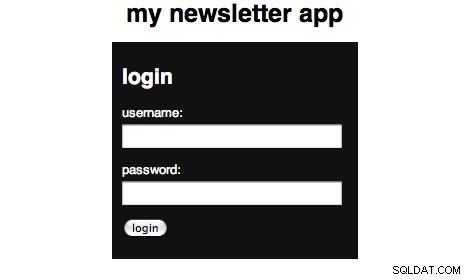

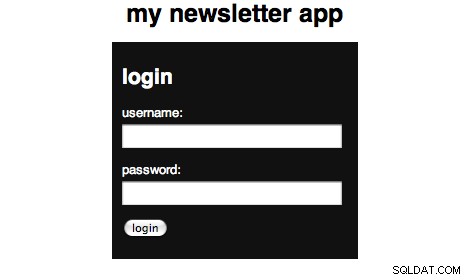
Também vamos criar um registro de usuário (e nossa tabela) para que possamos adicionar a lógica de autenticação e você possa visualizar as páginas com o código à frente. Para criar um usuário com o nome de usuário de admin e uma senha de segredo. Para adicionar isso, execute este SQL:
CREATE TABLE `users` (
`id` int(10) AUTO_INCREMENT,
`username` varchar(50),
`password` varchar(32),
PRIMARY KEY (`id`)
) ENGINE=MyISAM DEFAULT CHARSET utf8;
INSERT INTO `users` (`id`, `username`, `password`) VALUES
('1', 'admin', '5ebe2294ecd0e0f08eab7690d2a6ee69'); Etapa 5:boletins informativos
Eu projetei este aplicativo para ser muito flexível. Eu queria que você (usuário) pudesse criar e gerenciar quantas newsletters quiser. Então, primeiro, precisamos criar nossa tabela de banco de dados. Aqui está o código SQL da exportação no meu aplicativo de demonstração:
CREATE TABLE `newsletters` ( `id` int(10) AUTO_INCREMENT, `name` varchar(50), `description` varchar(255), `visible` varchar(10), PRIMARY KEY (`id`) ) ENGINE=MyISAM DEFAULT CHARSET utf8;
Agora que temos nossa tabela de newsletters, vamos criar as páginas para cada ação. Crie quatro arquivos chamados:newsletters.php, newsletters_delete.php, newsletters_edit.php e newsletters_new.php. Primeiro abra newsletters.php:
# admin/newsletters.php
<?php
require_once 'config.php';
login_required();
$title = "newsletters";
$newsletters = query("SELECT * FROM newsletters ORDER BY id ASC");
$tab = 'nl';
$table = "";
foreach($newsletters as $row) {
$dlink = '<a href="newsletters_delete.php?id='.$row['id'].'" onclick="return confirm(\'Are you sure you want to delete this newsletter?\');" title="delete"><img src="media/images/delete.png" alt="delete"/></a>';
$elink = '<a href="newsletters_edit.php?id='.$row['id'].'" title="edit" ><img src="media/images/page_edit.png" alt="edit"/></a>';
if($row['visible'] == "1") {$visible = '<img src="media/images/bullet_green.png" />';} else {$visible = '<img src="media/images/bullet_red.png" />';}
$table .= "<tr><td>".$row['id']."</td><td>".$row['name']."</td><td>".$row['description']."</td><td>$visible</td><td>".$dlink." ".$elink."</td></tr>\n";
}
$message = error_messages();
$content = <<<EOF
<a href="newsletters_new.php" class="large">new newsletter »</a>
$message
<table>
<tr>
<th></th>
<th>name</th>
<th>description</th>
<th>visible</th>
<th></th>
</tr>
$table
</table>
EOF;
include 'layout.php'; ?> Portanto, este arquivo tem a mesma sensação básica de nossa página de login. Exigimos nossa configuração, verifique se estamos logados, defina nosso título. Em seguida, usamos nossa função query() para realizar uma consulta SELECT para encontrar todos os nossos boletins. Em seguida, definimos a guia atual para nosso layout. Depois de percorrermos o array retornado por nossa consulta, criamos o layout da tabela. Então chamamos uma função ainda desconhecida e criamos nossa página. Antes de poder visualizar a página, você precisará adicionar o seguinte ao seu arquivo classes.php para lidar facilmente com nossas mensagens de erro:
# admin/classes.php
// Render error messages
function error_messages() {
$message = '';
if($_SESSION['success'] != '') {
$message = '<span class="success" id="message">'.$_SESSION['success'].'</span>';
$_SESSION['success'] = '';
}
if($_SESSION['error'] != '') {
$message = '<span class="error" id="message">'.$_SESSION['error'].'</span>';
$_SESSION['error'] = '';
}
return $message;
} Embora você provavelmente não tenha nenhum dado, quando tiver alguns registros, ele se parecerá com:(embora um pouco menos esmagado)
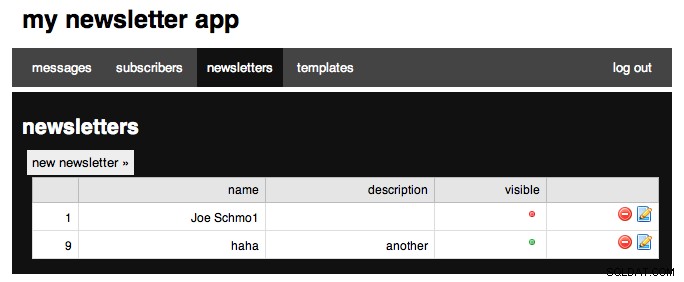
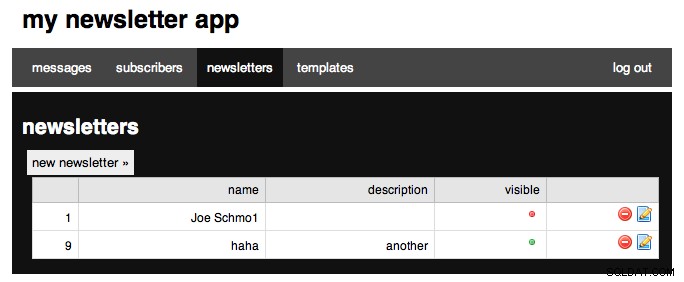
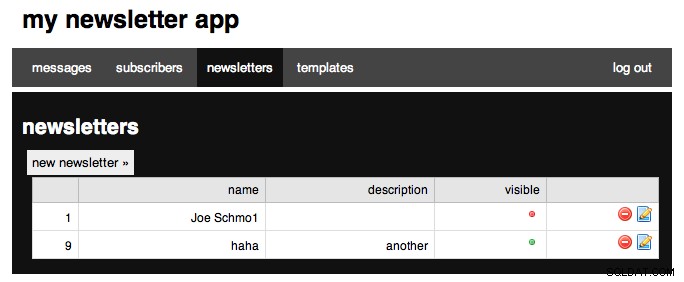
Agora vamos trabalhar em nossa nova ação, então abra newsletters_new.php e adicione o seguinte:
# admin/newsletters_new.php
<?php
require_once 'config.php';
login_required();
$tab = 'nl';
if(isset($_POST['submitted'])) {
$link = new mysqli(DB_SERVER, DB_USER, DB_PASSWORD, DB_NAME) or die('There was a problem connecting to the database.');
$sql = "INSERT INTO NEWSLETTERS (name, description) VALUES ( '".$_POST['name']."' , '".$_POST['description']."' )";
$stmt = $link->query($sql) or die($link->error);
$stmt->close;
$_SESSION['success'] = "Added newsletter.";
header('Location: newsletters.php');
}
$title = "new newsletter";
$content = <<<EOF
<form action="newsletters_new.php" method='POST'>
<p>
<label for="name">Name:</label><br />
<input type='text' name='name' class="text" />
</p>
<p>
<label for="description">Description:</label>
<input type="text" name="description" class="text" />
</p>
<p>
<input type='submit' value='Add Newsletter' />
<input type='hidden' value='1' name='submitted' />
</p>
</form>
EOF;
include 'layout.php'; ?> Então, espero que você tenha notado o padrão no topo de cada um de nossos arquivos. Primeiro exigimos nosso arquivo config.php, depois nos certificamos de que estamos logados e, em seguida, definimos nossa guia atual, adicionamos alguma lógica extra para lidar com POSTs e, em seguida, definimos nosso título, nosso conteúdo e renderizamos a página. A seção POST é bastante simples de entender, então vou explicar rapidamente.
Primeiro verificamos se um item com o nome de submetido foi enviado. Este é o campo oculto que temos após o botão enviar. Em seguida, criamos um link para nosso banco de dados usando as variáveis do nosso arquivo de configuração. Em seguida, criamos nossa consulta de inserção SQL, usando nossas variáveis POSTadas. Em seguida, consultamos (não nossa função) o banco de dados e, se um erro for gerado, mostramos o erro retornado. Em seguida, fechamos a consulta, definimos nossa mensagem de sucesso e redirecionamos para a página de listagem. Sua página deve ficar assim:
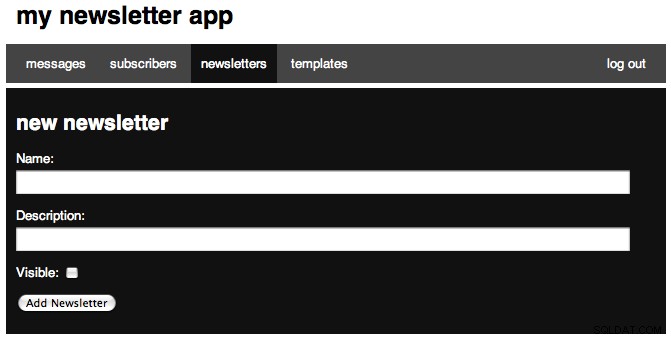
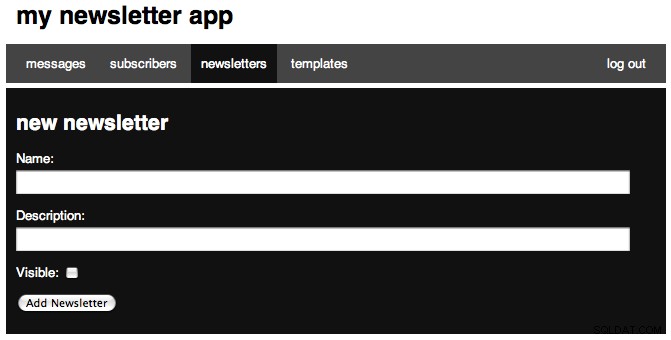
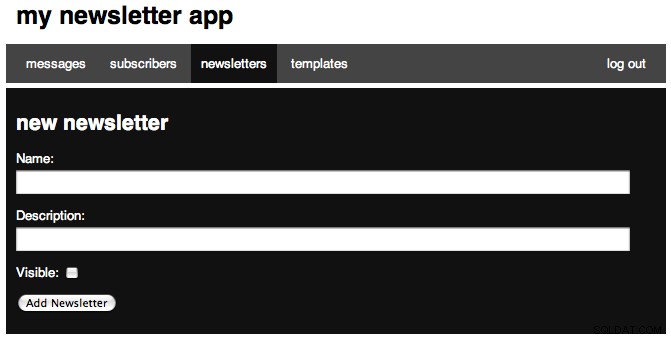
Em seguida, vamos trabalhar em nossa página de edição e adicionar o seguinte:
# admin/newsletters_edit.php
<?php
require_once 'config.php';
login_required();
$tab = 'nl';
if(isset($_POST['submitted'])) {
$link = new mysqli(DB_SERVER, DB_USER, DB_PASSWORD, DB_NAME) or die('There was a problem connecting to the database.');
if(isset($_POST['visible'])) {$visible = 1;}else{$visible = 0;}
$sql = "UPDATE NEWSLETTERS SET name='".$_POST['name']."', description='".$_POST['description']."', visible=".$visible." WHERE id=".$_POST['id']."";
$stmt = $link->query($sql) or die($link->error);
$stmt->close;
$_SESSION['success'] = "Edited newsletter.";
header('Location: newsletters.php');
}
$title = "edit newsletter";
$id = (int) $_GET['id'];
$results = query("SELECT * FROM newsletters WHERE id='".$id."' LIMIT 1");
$name = $results[0]['name'];
$description = $results[0]['description'];
$visible = ($results[0]['visible'] == "1") ? 'checked="checked"' : '';
$content = <<<EOF
<form action="newsletters_edit.php" method='POST'>
<p>
<label for="name">Name:</label><br />
<input type='text' name='name' class="text" value="$name" />
</p>
<p>
<label for="description">Description:</label>
<input type="text" name="description" class="text" value="$description" />
</p>
<p>
<label for="visible">Visible:</label>
<input type="checkbox" name="visible" value="true" $visible/>
</p>
<p>
<input type='submit' value='Edit Newsletter' />
<input type='hidden' value='1' name='submitted' />
<input type='hidden' value='$id' name='id' />
</p>
</form>
EOF;
include 'layout.php'; ?> Assim como todos os nossos arquivos, começamos com o mesmo bloco. Após o nosso bloco POST (sobre o qual falarei em um segundo), definimos id para nosso id solicitado, certificando-nos de que seja um inteiro. Em seguida, usamos nossa função de consulta para encontrar o boletim informativo com o qual estamos trabalhando e configuramos algumas variáveis para os resultados retornados. Você pode perguntar por que colocamos um [0] antes de solicitarmos cada valor, e o motivo é que a função de consulta retorna uma matriz de todos os registros e cada registro é uma matriz, portanto, precisamos acessar a primeira matriz em nossa variável de resultados . A linha onde definimos a variável visível if é na verdade uma instrução if/else compactada. a parte if é ==1, então se isso for verdade, a variável é definida como verificada, senão para nada. Então temos nosso formulário.
Nosso bloco POST é muito semelhante à nossa nova página e sempre começará da mesma maneira no restante de nossas páginas. Em seguida, verificamos se a caixa de seleção foi marcada e configuramos uma variável aqui novamente. Em seguida, temos nossa consulta UPDATE, executamos novamente a consulta, definimos nossa mensagem de sucesso e redirecionamos para casa. Esta é a aparência do formulário e a mensagem vista após a edição:
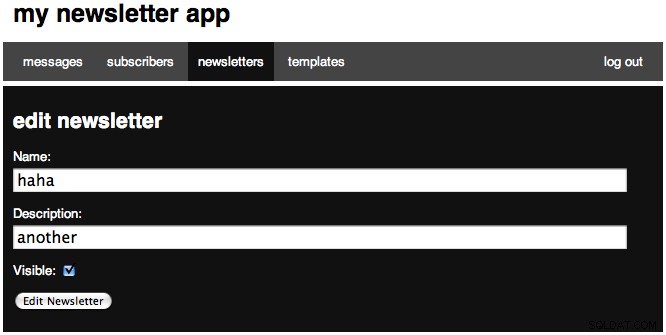
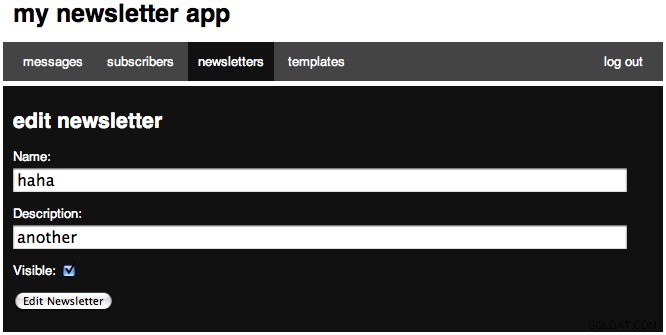
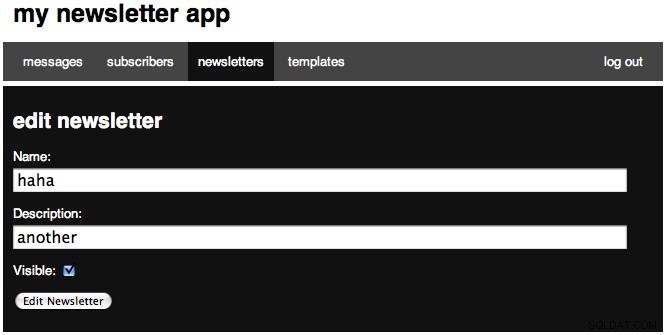
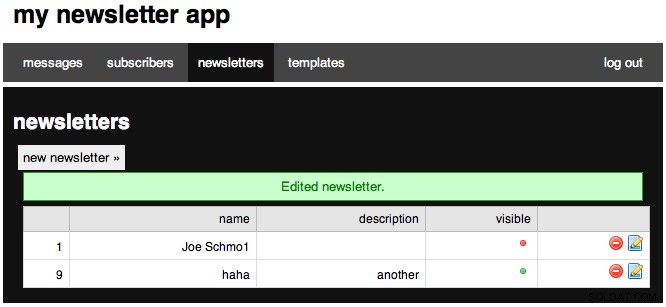
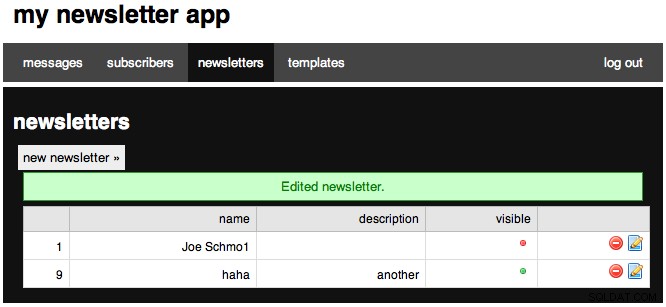
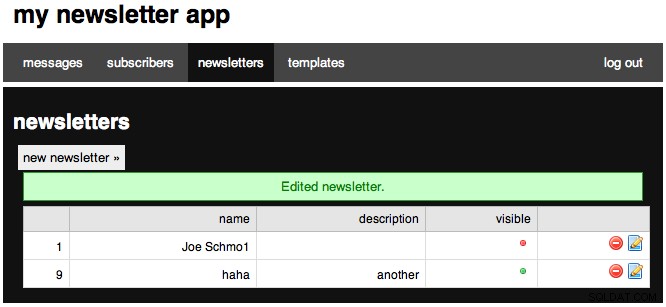
A última página desta seção é a mais fácil, pois é a página de exclusão. Abra o arquivo e cole no seguinte:
# admin/newsletters_delete.php
<?php
require_once 'config.php';
login_required();
$id = (int) $_GET['id'];
$link = new mysqli(DB_SERVER, DB_USER, DB_PASSWORD, DB_NAME) or die('There was a problem connecting to the database.');
$sql = "DELETE FROM newsletters WHERE id=$id LIMIT 1";
$stmt = $link->query($sql) or die($link->error);
if($link->affected_rows) {
$_SESSION['success'] = "Newsletter deleted.";
} else {
$_SESSION['error'] = 'Nothing deleted.';
}
header('Location: newsletters.php'); Neste bloco, exigimos nossa configuração, certifique-se de estar logado, salve o id solicitado em uma variável, crie uma conexão MySQL, configure nossa consulta SQL e execute a consulta. Em seguida, verificamos se uma linha foi afetada e define uma mensagem apropriadamente. Em seguida, redirecionamos para a página de newsletters. Parabéns, você terminou a primeira de quatro seções CRUD. Em seguida, trabalharemos no CRUD para nossos modelos.
Etapa 6:Modelos
Nosso aplicativo também permitirá vários modelos, todos armazenados no banco de dados. Primeiro, vamos criar nossa tabela de banco de dados:
CREATE TABLE `templates` ( `id` int(10) AUTO_INCREMENT, `name` varchar(50), `columns` tinyint(5), `body` text, PRIMARY KEY (`id`) ) ENGINE=MyISAM DEFAULT CHARSET utf8;
Temos uma coluna de id de incremento automático, uma coluna de nome, uma coluna de colunas para salvar o número de colunas (o aplicativo só dimensiona para 2 colunas, o que deve ser suficiente, mas pode ser facilmente expandido. Isso também pode ser usado para diferentes seções .), e nosso corpo. Assim como da última vez, precisamos fazer cada uma de nossas páginas, e teremos uma página templates.php, assim como templates_new.php, templates_edit.php, templates_delete.php e templates_preview.php. Primeiro vamos trabalhar em nosso arquivo templates.php, então abra-o e cole:
# admin/templates.php
<?php
require_once 'config.php';
login_required();
$title = "templates";
$tab = 'temp';
$templates = query("SELECT id,name,columns FROM templates ORDER BY id ASC");
$table = "";
foreach($templates as $row) {
$plink = '<a href="" onClick="window.open(\'templates_preview.php?id='.$row['id'].'\',width=800,height=600)" title="preview"><img src="media/images/find.png" alt="preview"/></a>';
$dlink = '<a href="templates_delete.php?id='.$row['id'].'" onclick="return confirm(\'Are you sure you want to delete this template?\');" title="delete"><img src="media/images/delete.png" alt="delete"/></a>';
$elink = '<a href="templates_edit.php?id='.$row['id'].'" title="edit"><img src="media/images/page_edit.png" alt="edit"/></a>';
$table .= "<tr><td>".$row['id']."</td><td>".$row['name']."</td><td>".$row['columns']."</td><td>".$plink." ".$dlink." ".$elink."</td></tr>\n";
}
$message = error_messages();
$content = <<<EOF
<a href="templates_new.php" class="large">new template »</a>
$message
<table>
<tr>
<th></th>
<th>name</th>
<th>columns</th>
<th></th>
</tr>
$table
</table>
EOF;
include 'layout.php'; ?> Novamente começamos com o básico. Em seguida, realizamos uma consulta para encontrar todos os nossos modelos. Em seguida, percorremos cada matriz em modelos e criamos uma tabela. Em seguida, recebemos nossas mensagens de erro (e sucesso) e, em seguida, nosso conteúdo. Sua página deve ser algo como:
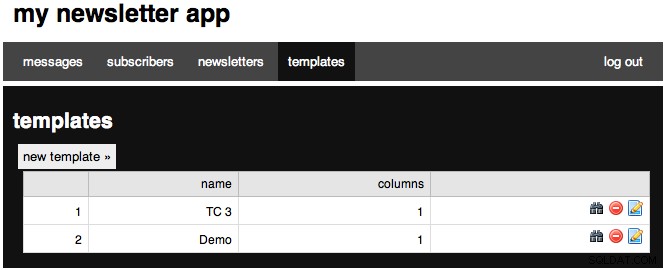
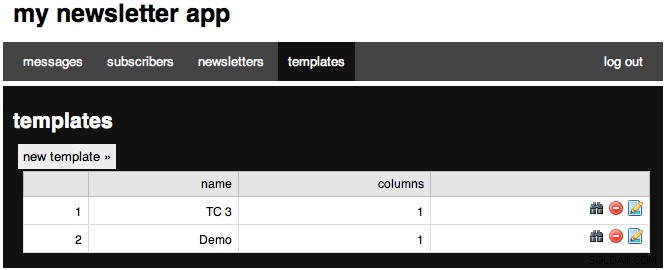

Agora, passando para nossa nova página, cole o seguinte:
# admin/templates_new.php
<?php
require_once 'config.php';
login_required();
$tab = 'temp';
if(isset($_POST['submitted'])) {
$link = new mysqli(DB_SERVER, DB_USER, DB_PASSWORD, DB_NAME) or die('There was a problem connecting to the database.');
$sql = "INSERT INTO templates (name, columns, body) VALUES ( '".$_POST['name']."' , ".$_POST['columns'].", '".mysql_real_escape_string($_POST['body'])."' )";
$stmt = $link->query($sql) or die($link->error);
$stmt->close;
$_SESSION['success'] = "Added template.";
header('Location: templates.php');
}
$title = "new template";
$content = <<<EOF
<form action="templates_new.php" method='POST'>
<p>
<label for="name">Name:</label><br />
<input type='text' name='name' class="text" />
</p>
<p>
<label for="columns">Columns</label>
<select name="columns">
<option value="1">Single Column Layout</option>
<option value="2">Two Column Layout</option>
</select>
</p>
<p>
<label for="description">Body: (raw html)</label><br />
Use %content% for a single column layout, %leftcol% and %rightcol% for a two column layout.<br />
<textarea name="body" rows="35"></textarea>
</p>
<p>
<input type='submit' value='Add Template' />
<input type='hidden' value='1' name='submitted' />
</p>
</form>
EOF;
include 'layout.php'; ?> Então, novamente, temos o mesmo cabeçalho. Nosso POST novamente cria uma conexão MySQL, então criamos nossa consulta, e usando mysql_real_escape_string para permitir qualquer caractere no registro, e então executamos nossa consulta, definimos nossa mensagem de sucesso e redirecionamos para nossa listagem de modelos. Se você olhar para o nosso formulário, também peço que sejam inseridas variáveis para o nosso conteúdo, e mostrarei como isso entra em jogo mais tarde, quando combinamos uma mensagem com um modelo. Sua página deve ficar assim:
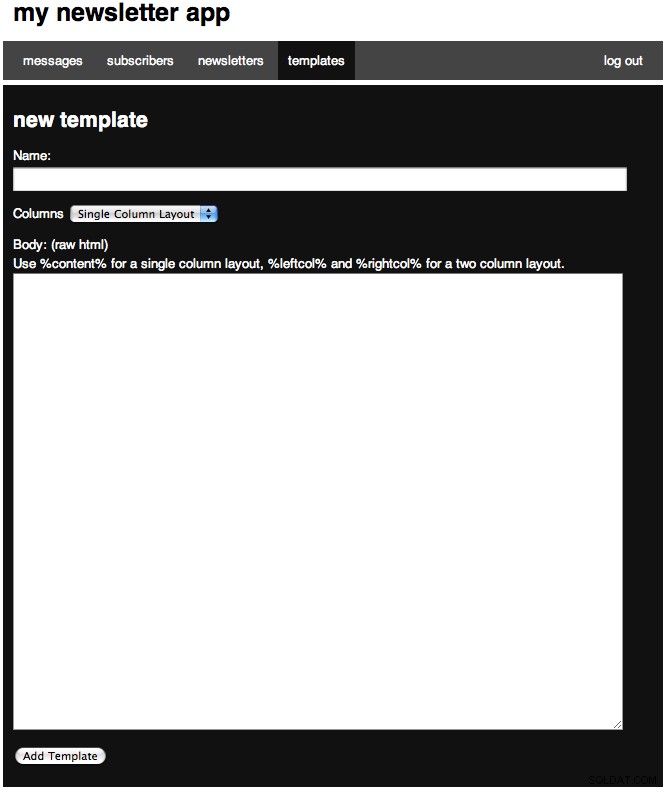
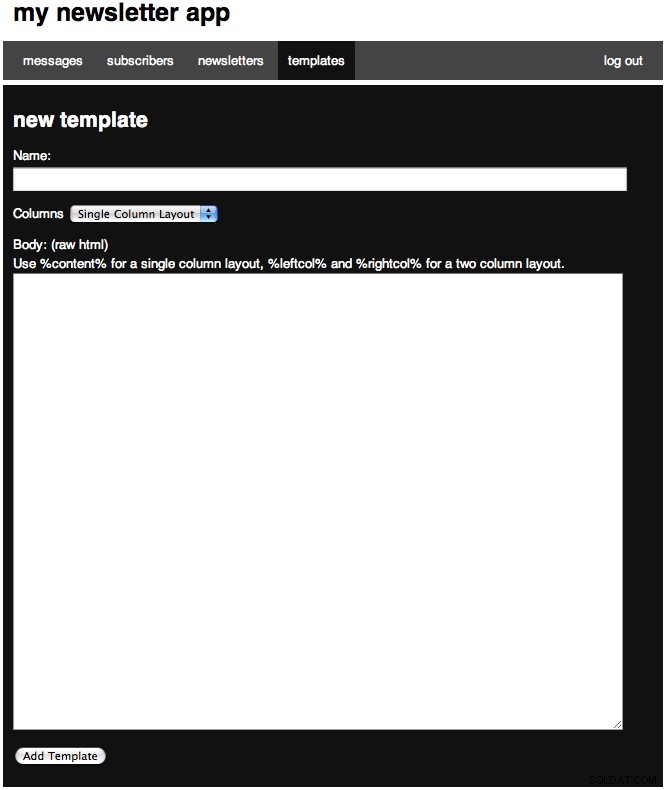
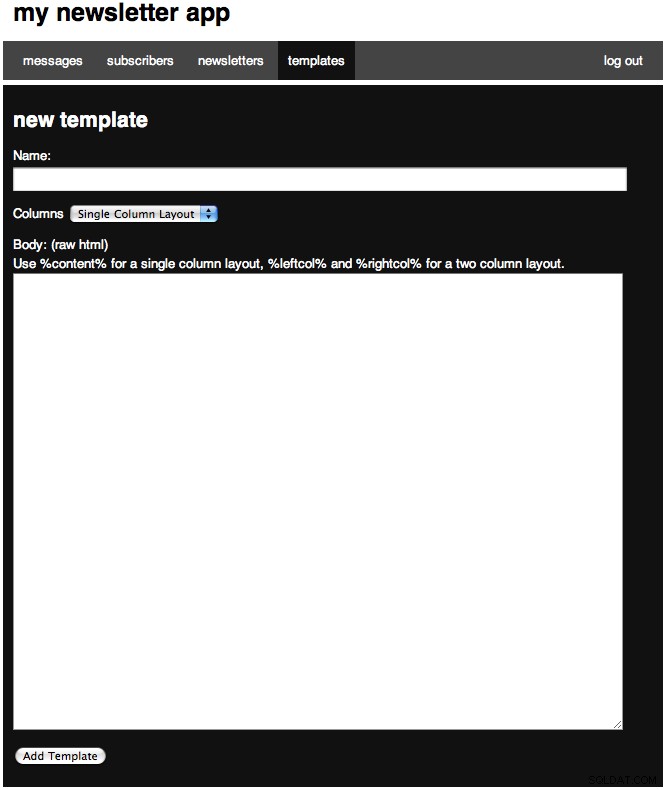
Em seguida, vamos trabalhar em nossa página de edição. Se você notou, grande parte desse código é copiar e colar em todas as mesmas ações, então facilite para você.
# admin/templates/edit.php
<?php
require_once 'config.php';
login_required();
$tab = 'temp';
if(isset($_POST['submitted'])) {
$link = new mysqli(DB_SERVER, DB_USER, DB_PASSWORD, DB_NAME) or die('There was a problem connecting to the database.');
$sql = "UPDATE templates SET name='".$_POST['name']."', body='".mysql_real_escape_string($_POST['body'])."', columns=".$_POST['columns']." WHERE id=".$_POST['id']."";
$stmt = $link->query($sql) or die($link->error);
$stmt->close;
$_SESSION['success'] = "Edited template.";
header('Location: templates.php');
}
$title = "edit template";
$id = (int) $_GET['id'];
$results = query("SELECT * FROM templates WHERE id='".$id."' LIMIT 1");
$name = $results[0]['name'];
$templatedata = stripslashes(htmlspecialchars($results[0]['body']));
$content = <<<EOF
<form action="templates_edit.php" method='POST'>
<p>
<label for="name">Name:</label><br />
<input type='text' name='name' class="text" value="$name"/>
</p>
<p>
<label for="columns">Columns</label>
<select name="columns">
<option value="1">Single Column Layout</option>
<option value="2">Two Column Layout</option>
</select>
</p>
<p>
<label for="body">Body: (raw html)</label><br />
Use %content% for a single column layout, %leftcol% and %rightcol% for a two column layout.<br />
<textarea name="body" rows="35">$templatedata</textarea>
</p>
<p>
<input type='submit' value='Edit Template' />
<input type='hidden' value='1' name='submitted' />
<input type='hidden' value='$id' name='id' />
</p>
</form>
EOF;
include 'layout.php'; ?> We start with the same intro, then our POST block, our title, then our requested id. After, we try and find the template we are working with, then sets three variables so that we can inset them into our content block. We also convert all of the tags we stored to HTML characters so everything will display. When looking at our POST block, you will notice we create our link, then our query and again use mysql_real_escape_string to save everything, execute our query, and then set our message, and redirect to our templates list. Your edit page (with a sample record) should look like:
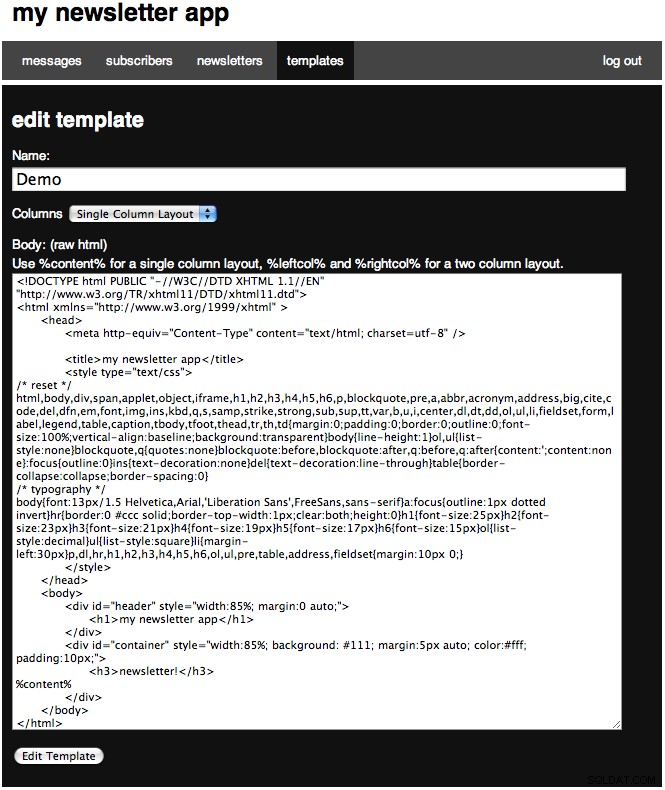
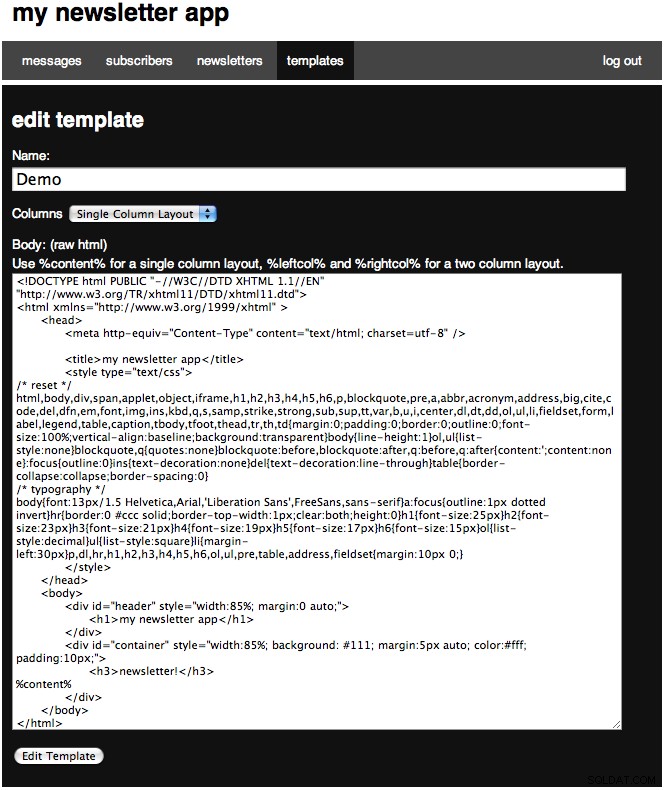
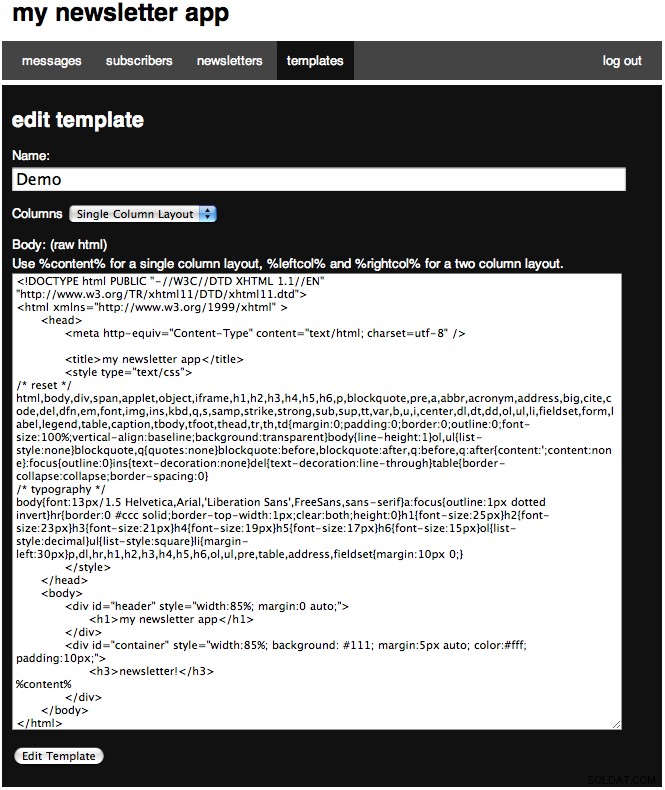
Now we will create another delete page, so open up our delete page and paste in:
# admin/templates_delete.php
<?php
require_once 'config.php';
login_required();
$id = (int) $_GET['id'];
$link = new mysqli(DB_SERVER, DB_USER, DB_PASSWORD, DB_NAME) or die('There was a problem connecting to the database.');
$sql = "DELETE FROM templates WHERE id=$id LIMIT 1";
$stmt = $link->query($sql) or die($link->error);
if($link->affected_rows) {
$_SESSION['success'] = "Template deleted.";
} else {
$_SESSION['error'] = 'Nothing deleted.';
}
header('Location: templates.php'); I hope you have picked up the pattern here, this is a very simple page. Now we are going to work on an extra page that is not part of the CRUD spectrum; we are going to create a preview page. The binoculars in the action part on the table is the link for each one (in a new window). So open up our preview page. The page is very simple, we find our template and echo the data, and then append a javascript close button. The code looks like:
# admin/templates_preview.php
<?php
require_once 'config.php';
login_required();
$id = (int) $_GET['id'];
$data = query("SELECT body FROM templates WHERE id=$id LIMIT 1");
$template = $data[0]['body'];
?>
<?php echo $template; ?>
<center><button type="button" onclick="self.close();">close window</button></center> And an example preview looks like:



Now we have finished with our Templates, we are ready to move onto the next step!
Step 7:Subscribers
So now we are going to work with our subscribers! We are going to create two tables. The first:
CREATE TABLE `subscribers` ( `id` tinyint(10) AUTO_INCREMENT, `name` varchar(50), `email` varchar(50), PRIMARY KEY (`id`) ) ENGINE=MyISAM DEFAULT CHARSET utf8;
Refers to each subscriber, and the second:
CREATE TABLE `subscriptions` ( `id` tinyint(10) AUTO_INCREMENT, `subscriber_id` tinyint(10), `newsletter_id` tinyint(10), PRIMARY KEY (`id`) ) ENGINE=MyISAM DEFAULT CHARSET utf8;
Creates a table for our many-to-many relationship with our newsletters. A subscriber can have multiple subscription to newsletters, so they can subscribe to multiple ones, and each newsletter can have many subscribers. To create the most dynamic solution, we have a linking table.
Let's first create our files. The files we are going are going to have are subscribers.php, subscribers_delete.php, and subscribers_edit.php. Our create action will be created later for the front-end. First open up subscribers.php and paste in:
# admin/subscribers.php
<?php
require_once 'config.php';
login_required();
$title = "subscribers";
$tab = 'sub';
$table = "";
$messages = query("SELECT * FROM subscribers ORDER BY id ASC");
foreach($messages as $row) {
$dlink = '<a href="subscribers_delete.php?id='.$row['id'].'" onclick="return confirm(\'Are you sure you want to delete this subscriber?\');" title="delete"><img src="media/images/delete.png" alt="delete"/></a>';
$elink = '<a href="subscribers_edit.php?id='.$row['id'].'" title="edit"><img src="media/images/page_edit.png" alt="edit"/></a>';
$table .= '<tr><td>'.$row['id'].'</td><td>'.$row['name'].'</td><td>'.$row['email'].'</td><td>'.$dlink.' '.$elink.'</td></tr>';
}
$message = error_messages();
$content = <<<EOF
$message
<table>
<tr>
<th></th>
<th>name</th>
<th>email</th>
<th></th>
</tr>
$table
</table>
EOF;
include 'layout.php'; ?> We have basically the same listing pages as before, except this time we will be finding our subscribers. Your page (with some sample data) should look like:
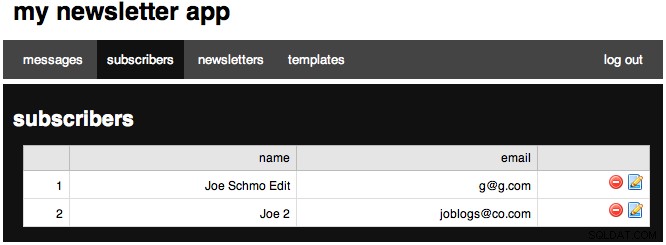
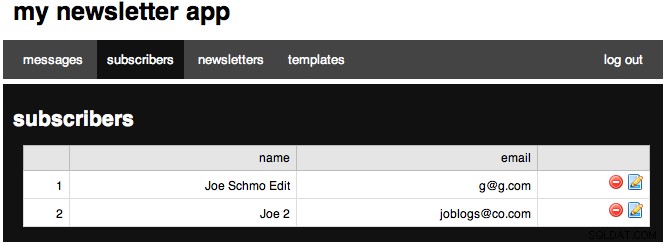
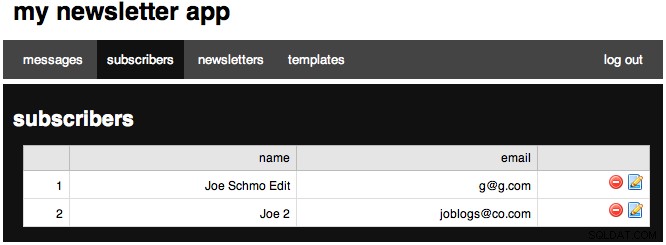
Now we will move on to our edit page:
# admin/subscribers_edit.php
<?php
require_once 'config.php';
login_required();
$tab = 'sub';
if(isset($_POST['submitted'])) {
$id = (int) $_POST['id'];
$link = new mysqli(DB_SERVER, DB_USER, DB_PASSWORD, DB_NAME) or die('There was a problem connecting to the database.');
$sql = "UPDATE subscribers SET name='".$_POST['name']."', email='".$_POST['email']."' WHERE id=$id";
$stmt = $link->query($sql) or die($link->error);
$stmt->close;
foreach($_POST['newsletter'] as $n) {
if($n['exists'] != '1' && $n['subscribe'] == "true") { // If we want to subscribe but the record doesnt exist
$nlid = $n['nlid'];
$sql = "INSERT INTO subscriptions (subscriber_id, newsletter_id) VALUES ('$id', '$nlid')";
$stmt = $link->query($sql) or die($link->error);
$stmt->close;
} elseif ($n['exists'] == '1' && $n['subscribe'] != "true") {// Else if we had an exits but we want to unsubscribe
$subid = $n['subid'];
$sql = "DELETE FROM subscriptions WHERE id=$subid LIMIT 1";
$stmt = $link->query($sql) or die($link->error);
$stmt->close;
}
}
$_SESSION['success'] = "Edited subscriber.";
header('Location: subscribers.php');
}
$title = "edit newsletter";
$id = (int) $_GET['id'];
$subscriber = query("SELECT * FROM subscribers WHERE id='$id'");
$name = $subscriber[0]['name'];
$email = $subscriber[0]['email'];
$newsletters = query("SELECT * FROM newsletters");
$subs = query("SELECT * FROM subscriptions WHERE subscriber_id='".$id."'");
$subscriptions = '';
foreach($newsletters as $nl) {
$s = false;
$subid = '';
foreach($subs as $sub) {
if($sub['newsletter_id'] == $nl['id']) {$s = true; $subid = $sub['id'];}
}
$checked = ($s == true) ? 'checked="checked"' : '';
$subscriptions .= '
<input type="checkbox" name="newsletter['.$nl["id"].'][subscribe]" value="true" '.$checked.'/>
<label for="newsletter['.$nl["id"].']">'.$nl['name'].'</label>
<input type="hidden" name="newsletter['.$nl["id"].'][exists]" value="'.$s.'" />
<input type="hidden" name="newsletter['.$nl["id"].'][nlid]" value="'.$nl['id'].'" />
<input type="hidden" name="newsletter['.$nl["id"].'][subid]" value="'.$subid.'" /><br />
';
}
$content = <<<EOF
<form action="subscribers_edit.php" method='POST'>
<p>
<label for="name">Name:</label><br />
<input type='text' name='name' class="text" value="$name" />
</p>
<p>
<label for="email">Email</label><br />
<input type="text" name="email" class="text" value="$email" />
</p>
<p>
<strong>Newsletters:</strong><br />
$subscriptions
</p>
<p>
<input type='submit' value='Edit Subscriber' />
<input type='hidden' value='1' name='submitted' />
<input type='hidden' value='$id' name='id' />
</p>
</form>
EOF;
include 'layout.php'; ?> This page is fairly different so I will explain each part. The header is the same we have been using. I'll skip the POST block and come back to it. We then continue the same code. We next find our current subscriber. Next we find all newsletters (this includes ones that are not visible - visible mean visible to the public) and then all of the subscriber's subscriptions. We next loop through every newsletter record returned, we next reset some values. Next, we loop through every subscription the user has, and if the subscription's newsletter_id is equal to the current newsletter we are looping we set $s true, and $subid equal to the subscription id. We then set the variable $checked equal to either checked or nothing depending on whether a subscription was found for this subscriber and the current newsletter in the loop. Next we create the checkbox form area, with a lot of hidden fields. First, we have the actual checkbox with a name that will create an array for each checkbox. We then have our label, and next we output whether or not the subscription exists, the newsletter_id and then the subscription_id for when the subscription exists. After which we have our normal content.
Now, if we move on to our POST block. We first get the id posted from our hidden field at the bottom. We next create our MySQL link. Next we have our first SQL query where we update the subscriber record. Next we loop through every newsletter checkbox. The first conditional statement checks to see if the POSTed data says we do not have an existing subscription, and the user wants to subscribe to the newsletter. To handle this, we are going to perform a SQL INSERT into our subscriptions table where our subscriber_id is the same as the user_id we are editing, and newsletter_id equal to the 'nlid' value POSTed by one of our hidden fields. We then execute that SQL INSERT query. The elseif conditional statement says that if our subscription exists, but the checkbox was unchecked so we unsubscribe, we need to delete the subscription. We handle this with a SQL DELETE query. To form our query we set $subid equal to the posted value for our 'subid'. We then create our query by deleting the record where the subscription id equals our variable of $subid. Next we execute the query, set our session success message, and then redirect back to our subscribers page. Your final edit page should look like:(filled with sample data)

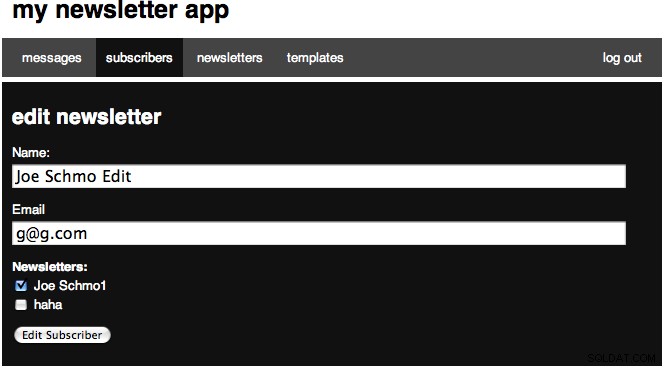
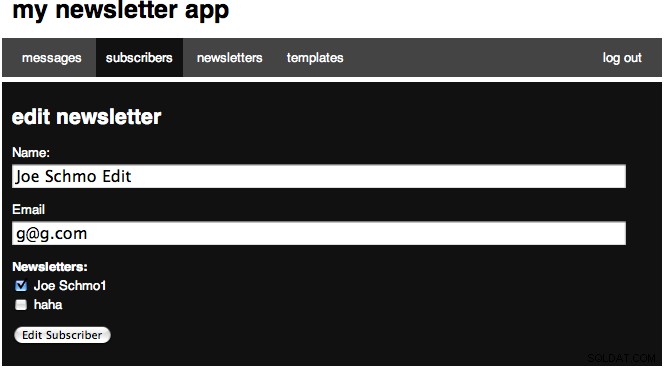
We have one last page to work on for the subscribers part of the backend:the delete page. Just like before, this page is very simple:
# admin/subscribers_delete.php
<?php
require_once 'config.php';
login_required();
$id = (int) $_GET['id'];
$link = new mysqli(DB_SERVER, DB_USER, DB_PASSWORD, DB_NAME) or die('There was a problem connecting to the database.');
$sql = "DELETE FROM subscribers WHERE id=$id LIMIT 1";
$stmt = $link->query($sql) or die($link->error);
if($link->affected_rows) {
$_SESSION['success'] = "Subscriber deleted.";
} else {
$_SESSION['error'] = 'Nothing deleted.';
}
header('Location: subscribers.php'); Step 8:Messages
I will tell you upfront, this section has the most pages. We will be working with seven now, and creating one more in Step 10. First, we are going to create our messages table with this SQL:
CREATE TABLE `messages` ( `id` tinyint(10) AUTO_INCREMENT, `subject` varchar(255), `leftcol` text, `rightcol` text, `template_id` tinyint(10), PRIMARY KEY (`id`) ) ENGINE=MyISAM DEFAULT CHARSET utf8;
Next, we'll create the files for this step. Creates seven files, each named messages.php, messages_delete.php, messages_edit.php, messages_new.php, messages_new_step2.php, messages_new_step3.php, and messages_preview.php. Let's first open up messages.php and make it look like:
# admin/messages.php
<?php
require_once 'config.php';
login_required();
$title = "messages";
$tab = 'mess';
$table = "";
$messages = query("SELECT * FROM messages ORDER BY id ASC");
foreach($messages as $row) {
$slink = '<a href="messages_send.php?id='.$row['id'].'" title="send message"><img src="media/images/email_go.png" alt="send message"/></a>';
$plink = '<a href="messages_preview.php?id='.$row['id'].'" target="_new" title="preview"><img src="media/images/find.png" alt="preview"/></a>';
$dlink = '<a href="messages_delete.php?id='.$row['id'].'" onclick="return confirm(\'Are you sure you want to delete this message?\');" title="delete"><img src="media/images/delete.png" alt="delete"/></a>';
$elink = '<a href="messages_edit.php?id='.$row['id'].'" title="edit"><img src="media/images/page_edit.png" alt="edit"/></a>';
$table .= '<tr><td>'.$row['id'].'</td><td>'.$row['subject'].'</td><td><a href="" onClick="window.open(\'templates_preview.php?id='.$row['template_id'].'\',width=800,height=600)" title="preview"><img src="media/images/find.png" alt="preview"/></a></td><td>'.$slink.' '.$plink.' '.$dlink.' '.$elink.'</td></tr>';
}
$message = error_messages();
$content = <<<EOF
<a href="messages_new.php" class="large">new message »</a>
$message
<table>
<tr>
<th></th>
<th>subject</th>
<th>template</th>
<th></th>
</tr>
$table
</table>
EOF;
include 'layout.php'; ?> This is our routine table, except we now have 4 'extra' links now, one to send the message, one to preview, one to edit, and one to delete. Your page should look like:
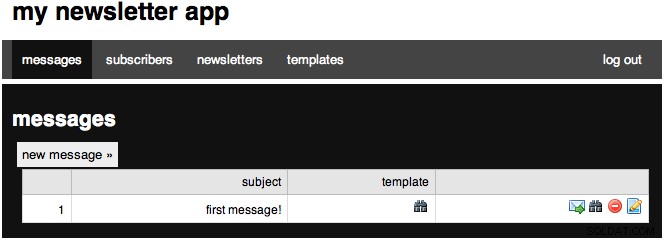
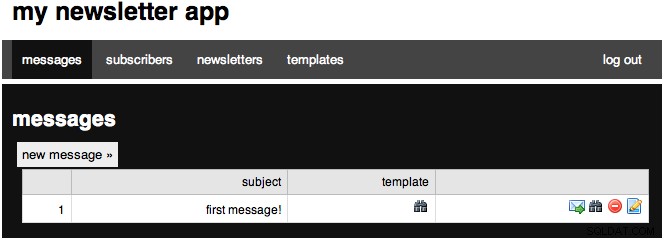
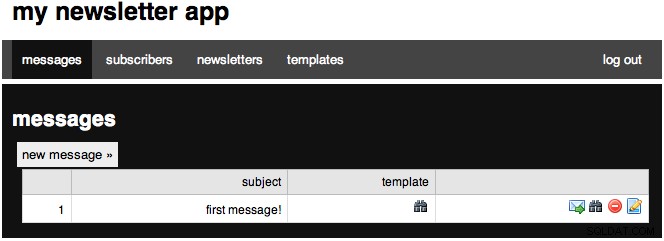
Now we are going to start work on our new pages. The first page is where all messages start out, and then you can progress on and enter the actual message on the next page. The reason for this is because we first need to create the initial message in the DB and so we can find information about the template. The step2 page is basically the edit page (there are six line differences according to FileMerge). Open up our new file and paste the following:
# admin/messages_new.php
<?php
require_once 'config.php';
login_required();
$tab = 'mess';
if(isset($_POST['subject'])) {
$link = new mysqli(DB_SERVER, DB_USER, DB_PASSWORD, DB_NAME) or die('There was a problem connecting to the database.');
$sql = "INSERT INTO messages (subject, template_id) VALUES ( '".$_POST['subject']."' , ".$_POST['template'].")";
$stmt = $link->query($sql) or die($link->error);
$i = query("SELECT id FROM messages WHERE subject='".$_POST['subject']."' AND template_id=".$_POST['template']." ");
$id = $i[0]['id'];
$stmt->close;
$_SESSION['success'] = "Added template.";
header('Location: messages_new_step2.php?id=' + $id);
}
$title = "new message";
$templates = query("SELECT id,name,columns FROM templates");
$tselect = '<select name="template">';
foreach($templates as $row) {
$tselect .= '<option value="'.$row['id'].'">'.$row['name'].'</option>';
}
$tselect .= "</select>";
$content = <<<EOF
<form action="messages_new.php" method='POST'>
<p>
<label for="subject">Subject:</label><br />
<input type='text' name='subject' class="text" />
</p>
<p>
<label for="template">Template:</label>
$tselect
</p>
<p>
<button onclick="">Continue »</button>
</p>
</form>
EOF;
include 'layout.php'; ?> This page is very similar to what our other new pages look like, but this one was one change in the POST block. Right after we perform the SQL INSERT, we find the most recent insert id. Now this is not the perfect solution, but I prefer it to performing another SQL query to find a row using unindexed columns. This step should look like:
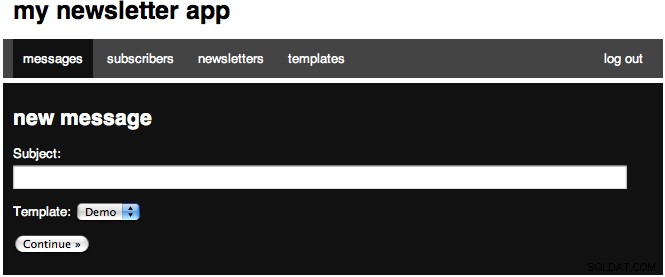
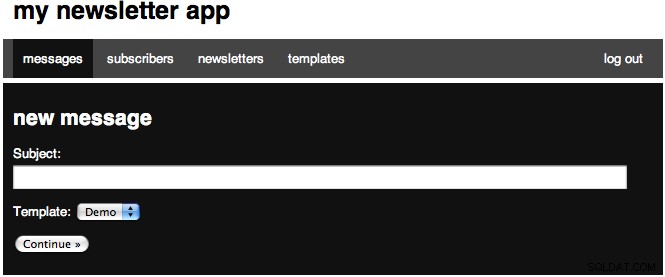
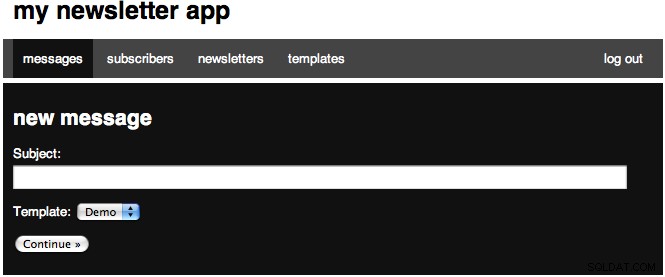
We then redirect to step2, so let's open up the file:
# admin/messages_new_step2.php
<?php
require_once 'config.php';
login_required();
$title = "new message - step 2";
$tab = 'mess';
$id = (int) $_GET['id'];
$mess = query("SELECT * FROM messages WHERE id=$id");
$message = $mess[0];
$subject = $message['subject'];
$templates = query("SELECT id,name,columns FROM templates");
$tselect = '<select name="template">';
foreach($templates as $row) {
if($message['template_id'] == $row['id']) {
$selected = ' selected="selected"';
if($row['columns'] == "1") {
$textareas = '<p><label for="body">Body: (raw html)</label><br /><textarea name="body" rows="35"></textarea></p>';
} else {
$textareas = '<p><label for="leftcol">Left column: (raw html)</label><br /><textarea name="leftcol" rows="35"></textarea></p>
<p><label for="rightcol">Right column: (raw html)</label><br /><textarea name="rightcol" rows="35"></textarea></p>';
}
} else {$selected = '';}
$tselect .= '<option value="'.$row['id'].'"'.$selected.'>'.$row['name'].'</option>';
}
$tselect .= '</select>';
// Check for a POST
if(isset($_POST['submitted'])) {
$link = new mysqli(DB_SERVER, DB_USER, DB_PASSWORD, DB_NAME) or die('There was a problem connecting to the database.');
$template = query("SELECT columns FROM templates WHERE id=".$message['template_id']);
if($template[0]['columns'] == "1") {
$body = mysql_real_escape_string($_POST['body']);
$sql = "UPDATE messages SET subject='".$_POST['subject']."', leftcol='$body' WHERE id=$id";
} else {
$leftcol = mysql_real_escape_string($_POST['leftcol']);
$rightcol = htmlentities($_POST['rightcol']);
$sql = "UPDATE messages SET subject='".$_POST['subject']."', leftcol='$leftcol', rightcol='$rightcol' WHERE id=$id";
}
$stmt = $link->query($sql) or die($link->error);
$stmt->close;
header('Location: messages_new_step3.php?id='.$id);
}
$content = <<<EOF
<form action="messages_new_step2.php?id=$id" method='POST'>
<p>
<label for="subject">Subject:</label><br />
<input type='text' name='subject' class="text" value="$subject"/>
</p>
<p>
<label for="template">Template:</label>
$tselect
</p>
$textareas
<p>
<input type='submit' value='Continue »' />
<input type='hidden' value='1' name='submitted' />
</p>
</form>
EOF;
include 'layout.php'; ?> Hopefully you have gotten the gist of all the pages and understand the page above. We have our normal heading. we then set our id from our GET request. Next we find the message we are working with, then we find all the templates and construct a drop down. We also use this look to define whether we will have one or two textareas. Next we have our POST block, which creates the link, then checks to see if we are working with one or two columns and creates the appropriate SQL query. After that we have our form. Your form should look like:
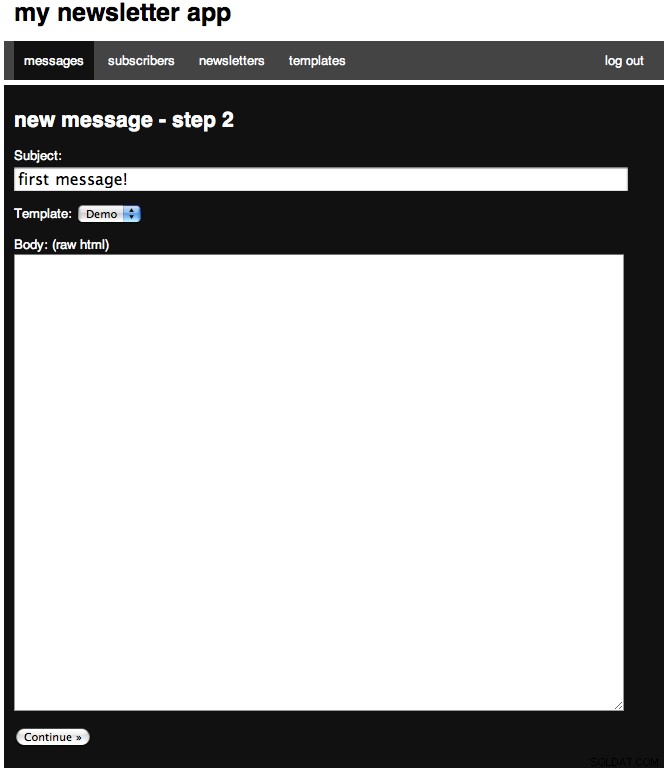
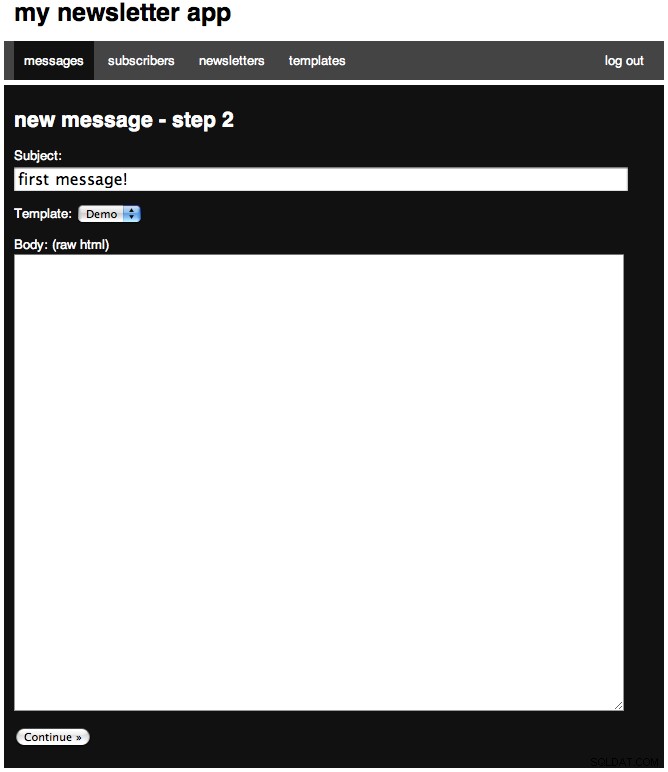
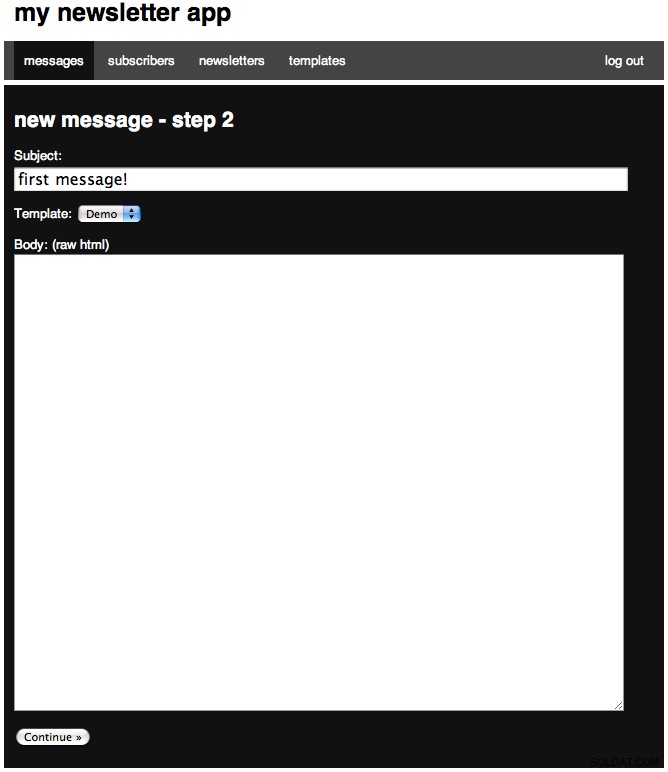
Now we will continue onto step 3, so open up the file and paste:
# admin/messages_new_step3.php
<?php
require_once 'config.php';
login_required();
$title = "new message - step 3";
$id = (int) $_GET['id'];
$tab = 'mess';
$mess = query("SELECT * FROM messages WHERE id=$id");
$message = $mess[0];
$subject = $message['subject'];
$content = <<<EOF
<a href="messages_preview.php?id=$id" class="large" target="_new">preview »</a><br />
<p>Do you want to <a href="messages.php" class="large">return to messages</a> or <a href="messages_send.php?id=$id" class="large">send the message</a>?</p>
EOF;
include 'layout.php';
?> The page is very simple and is the end of creating a message. It offers us a few links. The first is a link to preview the message. The next offers to take us back home. The third offers to take us to send the message (Step 10). The page looks like:



Now we are going to continue on to our edit page. I will not explain it as it is the same file as messages_new_step2.php, so you can refer there.
# admin/messages_edit.php
<?php
require_once 'config.php';
login_required();
$title = "edit message";
$id = (int) $_GET['id'];
$tab = 'mess';
$mess = query("SELECT * FROM messages WHERE id=$id");
$message = $mess[0];
$subject = $message['subject'];
$templates = query("SELECT id,name,columns FROM templates");
$tselect = '<select name="template">';
foreach($templates as $row) {
if($message['template_id'] == $row['id']) {
$selected = ' selected="selected"';
} else {$selected = '';}
$tselect .= '<option value="'.$row['id'].'"'.$selected.'>'.$row['name'].'</option>';
}
$tselect .= '</select>';
$mid = $message['template_id'];
$template = query("SELECT id,name,columns FROM templates WHERE id=$mid");
if($template[0]['columns'] == "1") {
$textareas = '<p><label for="body">Body: (raw html)</label><br /><textarea name="body" rows="35">'.$message['leftcol'].'</textarea></p>';
} else {
$textareas = '<p><label for="leftcol">Left column: (raw html)</label><br /><textarea name="leftcol" rows="35">'.$message['leftcol'].'</textarea></p>
<p><label for="rightcol">Right column: (raw html)</label><br /><textarea name="rightcol" rows="35">'.$message['rightcol'].'</textarea></p>';
}
// Check for a POST
if(isset($_POST['submitted'])) {
$link = new mysqli(DB_SERVER, DB_USER, DB_PASSWORD, DB_NAME) or die('There was a problem connecting to the database.');
if($template[0]['columns'] == "1") {
$body = mysql_real_escape_string($_POST['body']);
$sql = "UPDATE messages SET subject='".$_POST['subject']."', leftcol='$body' WHERE id=$id";
} else {
$leftcol = mysql_real_escape_string($_POST['leftcol']);
$rightcol = htmlentities($_POST['rightcol']);
$sql = "UPDATE messages SET subject='".$_POST['subject']."', leftcol='$leftcol', rightcol='$rightcol' WHERE id=$id";
}
$stmt = $link->query($sql) or die($link->error);
$stmt->close;
$_SESSION['success'] = "Edited message.";
header('Location: messages.php');
}
$content = <<<EOF
<form action="messages_edit.php?id=$id" method='POST'>
<p>
<label for="subject">Subject:</label><br />
<input type='text' name='subject' class="text" value="$subject"/>
</p>
<p>
<label for="template">Template:</label>
$tselect
</p>
$textareas
<p>
<input type='submit' value='Save »' />
<input type='hidden' value='1' name='submitted' />
</p>
</form>
EOF;
include 'layout.php'; ?> The page will look almost identical to our step 2, but the textarea will have content. Now we will create the delete page with:
# admin/messages_delete.php
<?php
require_once 'config.php';
login_required();
$id = (int) $_GET['id'];
$link = new mysqli(DB_SERVER, DB_USER, DB_PASSWORD, DB_NAME) or die('There was a problem connecting to the database.');
$sql = "DELETE FROM messages WHERE id=$id LIMIT 1";
$stmt = $link->query($sql) or die($link->error);
if($link->affected_rows) {
$_SESSION['success'] = "Message deleted.";
} else {
$_SESSION['error'] = 'Nothing deleted.';
}
header('Location: messages.php'); ?> That page should also look familiar. The final page we are going to work on in this step is our preview page, so open it up and place:
# admin/messages_preview.php
<?php
require_once 'config.php';
login_required();
$id = (int) $_GET['id'];
$mess = query("SELECT * FROM messages WHERE id=$id");
$message = $mess[0];
$subject = $message['subject'];
$tid = $message['template_id'];
$data = query("SELECT body,columns FROM templates WHERE id=$tid LIMIT 1");
$template = $data[0]['body'];
if($data[0]['columns'] == "1") {
$leftcol = $message['leftcol'];
$body = str_replace('%content%', $leftcol, $template);
} else {
$leftcol = $message['leftcol'];
$rightcol = $message['rightcol'];
$b = str_replace('%leftcol%', $leftcol, $template);
$body = str_replace('%rightcol%', $rightcol, $b);
}
?>
<?php echo $body; ?>
<button type="button" onclick="self.close();">close window</button> This file is somewhat different than you have seen, so I'll walk you through it. First have have our normal heading. Next we find the current message we are working with, and set a few variables to the results. Next we find the template we are working with and set a variable equal to the body. Next, we have a conditional statement that checks to see the number of columns the template has. If it has we use the PHP function str_replace to replace the %content% tag we have with our actual content. Otherwise, we first perform a str_replace for the left column, and then on the result of that we perform str_replace again for the right column. Now we are ready to continue onto the front-end.
Step 9:The Front-End
We have finally reached the front-end! For this step and this step only, I will assume the files we are working with are in the root of the project (so not the admin folder, the one containing it). We are going to be working with four files here, so go ahead and create index.php, preferences.php, subscribe.php and a style.css file. First open up our index.php file and paste:
# index.php
<?php
require_once 'admin/config.php';
$newsletters = query("SELECT * FROM newsletters WHERE visible=1");
$subscriptions = '';
foreach($newsletters as $nl) {
$subscriptions .= '
<input type="checkbox" name="newsletter['.$nl["id"].'][subscribe]" value="true" '.$checked.'/>
<label for="newsletter['.$nl["id"].']">'.$nl['name'].'</label>
<input type="hidden" name="newsletter['.$nl["id"].'][nlid]" value="'.$nl['id'].'" /><br />
'.$nl["description"].'<br />
';
}
?>
<!DOCTYPE html PUBLIC "-//W3C//DTD XHTML 1.1//EN" "http://www.w3.org/TR/xhtml11/DTD/xhtml11.dtd">
<html xmlns="http://www.w3.org/1999/xhtml" >
<head>
<meta http-equiv="Content-Type" content="text/html; charset=utf-8" />
<title>my newsletters</title>
<!-- Stylesheets -->
<link rel="stylesheet" href="style.css" type="text/css" media="all" />
</head>
<body>
<div id="header">
<h1>my newsletters</h1>
</div>
<div id="container">
<h3>Subscribe to our newsletters!</h3>
<form action="subscribe.php" method="POST">
<p>
<label for="name">Name:</label><br />
<input type='text' name='name' class="text" />
</p>
<p>
<label for="email">Email</label><br />
<input type="text" name="email" class="text" />
</p>
<p>
<strong>Newsletters:</strong><br />
<?php echo $subscriptions; ?>
</p>
<p>
<input type='submit' value='Subscribe »' />
<input type='hidden' value='1' name='submitted' />
</p>
</form>
</div>
</body>
</html> I'll explain the page first and then we will get to the picture so-far and the page styling. In the PHP section at the top we require our config.php file (now in the admin directory), then find all of our publicly visible newsletters and create a check box array. You will notice that we are not handling the POSTed data here, and I chose to do that in our subscribe.php, and we will get to that, but first let's style the page. The page should currently look like:
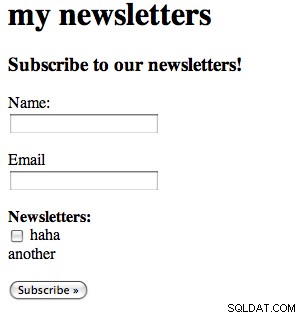
First I added the 960.gs reset file like I did in our other stylesheet. Then I added the three following styles to make the design look like:
# style.css
#header, #container {width:65%;margin:0 auto; padding:0.7%;}
#container {background:#ccc;}
form input.text {width:95%; font-size:16px;}
#message.success {border:solid 1px #349534; background:#C9FFCA;color:#008000;} 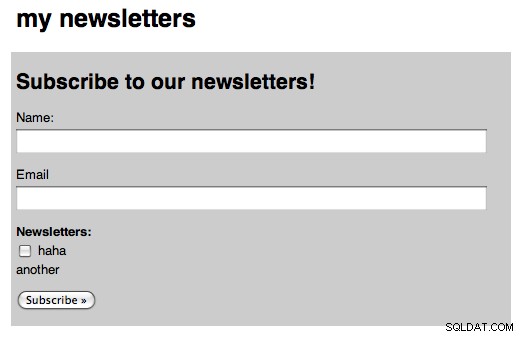

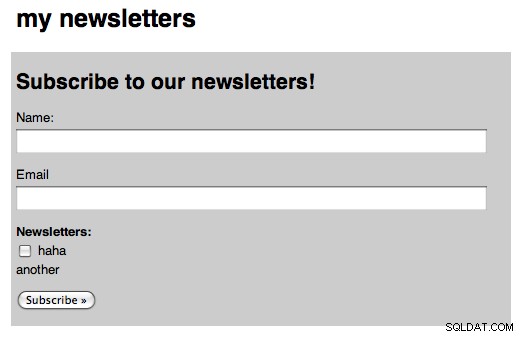
So now that we have a clean and simple page, we are going to continue on and work on our subscribe.php file. Go ahead and open the file and paste:
# subscribe.php
<?php
require_once 'admin/config.php';
if(isset($_POST['submitted'])) {
$link = new mysqli(DB_SERVER, DB_USER, DB_PASSWORD, DB_NAME) or die('There was a problem connecting to the database.');
$name = $_POST['name'];
$email = $_POST['email'];
$sql = "INSERT INTO subscribers (name, email) VALUES ('$name', '$email')";
$stmt = $link->query($sql) or die($link->error);
$stmt->close;
$sql = "SELECT id FROM subscribers WHERE name='$name' AND email='$email' LIMIT 1";
$subscriber = query($sql);
$id = $subscriber[0]['id'];
foreach($_POST['newsletter'] as $n) {
if($n['subscribe'] == "true") { // If we want to subscribe but the record doesnt exist
$nlid = $n['nlid'];
$sql = "INSERT INTO subscriptions (subscriber_id, newsletter_id) VALUES ('$id', '$nlid')";
$stmt = $link->query($sql) or die($link->error);
$stmt->close;
}
}
} else {header('Location: index.php');}
?>
<!DOCTYPE html PUBLIC "-//W3C//DTD XHTML 1.1//EN" "http://www.w3.org/TR/xhtml11/DTD/xhtml11.dtd">
<html xmlns="http://www.w3.org/1999/xhtml" >
<head>
<meta http-equiv="Content-Type" content="text/html; charset=utf-8" />
<title>my newsletters</title>
<!-- Stylesheets -->
<link rel="stylesheet" href="style.css" type="text/css" media="all" />
</head>
<body>
<div id="header">
<h1>my newsletters</h1>
</div>
<div id="container">
<h3>Thank you for subscribing!</h3>
</div>
</body>
</html> This page is very much like our edit subscribers page, but no DELETE SQL queries happen here. We simply check to make sure we have all POSTed data. We then set a few variables to our POSTed data, and then create and perform a SQL INSERT query to add the person to our subscribers table. After which we perform a SQL query to find that just created subscriber (insert_id was not working this time for me). We then loop through all of the POSTed newsletters and check to see if we want to subscribe to them, and perform SQL INSERTs when needed. If all goes to plan, you see a nice screen like the one below:



We have on last page here to work on, and that is the preferences.php file. This is where a user can edit their email subscription. I am going to split the page in two. First we have our PHP block:
# preferences.php
<?php
require_once 'admin/config.php';
if(isset($_POST['submitted'])) {
$id = (int) $_POST['id'];
$link = new mysqli(DB_SERVER, DB_USER, DB_PASSWORD, DB_NAME) or die('There was a problem connecting to the database.');
$sql = "UPDATE subscribers SET name='".$_POST['name']."', email='".$_POST['email']."' WHERE id=$id";
$stmt = $link->query($sql) or die($link->error);
$stmt->close;
foreach($_POST['newsletter'] as $n) {
if($n['exists'] != '1' && $n['subscribe'] == "true") { // If we want to subscribe but the record doesnt exist
$nlid = $n['nlid'];
$sql = "INSERT INTO subscriptions (subscriber_id, newsletter_id) VALUES ('$id', '$nlid')";
$stmt = $link->query($sql) or die($link->error);
$stmt->close;
} elseif ($n['exists'] == '1' && $n['subscribe'] != "true") {// Else if we had an exits but we want to unsubscribe
$subid = $n['subid'];
$sql = "DELETE FROM subscriptions WHERE id=$subid LIMIT 1";
$stmt = $link->query($sql) or die($link->error);
$stmt->close;
}
}
$_SESSION['success'] = "Preferences saved.";
}
if(isset($_GET['email'])) {$email = $_GET['email']; $display = 'form';} else {$display = 'find';}
$subscriber = query("SELECT * FROM subscribers WHERE email='$email'");
if($subscriber || $display == 'find') {
$id = $subscriber[0]['id'];
$name = $subscriber[0]['name'];
$email = $subscriber[0]['email'];
} else {header('Location: index.php');}
$newsletters = query("SELECT * FROM newsletters WHERE visible=1");
$subs = query("SELECT * FROM subscriptions WHERE subscriber_id='".$id."'");
$subscriptions = '';
foreach($newsletters as $nl) {
$s = false;
$subid = '';
foreach($subs as $sub) {
if($sub['newsletter_id'] == $nl['id']) {$s = true; $subid = $sub['id'];}
}
$checked = ($s == true) ? 'checked="checked"' : '';
$subscriptions .= '
<input type="checkbox" name="newsletter['.$nl["id"].'][subscribe]" value="true" '.$checked.'/>
<label for="newsletter['.$nl["id"].']">'.$nl['name'].'</label>
<input type="hidden" name="newsletter['.$nl["id"].'][exists]" value="'.$s.'" />
<input type="hidden" name="newsletter['.$nl["id"].'][nlid]" value="'.$nl['id'].'" />
<input type="hidden" name="newsletter['.$nl["id"].'][subid]" value="'.$subid.'" /><br />
';
}
$message = error_messages();
?> In this block, a lot is going on. First, we include our config file. Next, we check for a POST, and if we have one, we update our database. This portion is copied exactly from our subscribers_edit.php file so you can look there for a bit more explanation. Next depending on if we have a get request, we set our variable (this variable is used in the HTML section of the page). We then look for a subscriber with that email, and if one exists or we are showing the find portion, we continue, otherwise we are redirected home. Next we find all of our newsletters, and all of the subscriber's subscriptions, and then create our checkbox form. The HTML portion looks like:
# preferences.php
<!DOCTYPE html PUBLIC "-//W3C//DTD XHTML 1.1//EN" "http://www.w3.org/TR/xhtml11/DTD/xhtml11.dtd">
<html xmlns="http://www.w3.org/1999/xhtml" >
<head>
<meta http-equiv="Content-Type" content="text/html; charset=utf-8" />
<title>my newsletters - my preferences</title>
<!-- Stylesheets -->
<link rel="stylesheet" href="style.css" type="text/css" media="all" />
</head>
<body>
<div id="header">
<h1>my newsletters</h1>
</div>
<div id="container">
<h3>my preferences</h3>
<?php if($display == 'form') {?>
<form action="preferences.php" method="POST">
<p>
<label for="name">Name:</label><br />
<input type='text' name='name' class="text" value="<?php echo $name; ?>"/>
</p>
<p>
<label for="email">Email</label><br />
<input type="text" name="email" class="text" value="<?php echo $email; ?>"/>
</p>
<p>
<strong>Newsletters:</strong><br />
<?php echo $subscriptions; ?>
</p>
<p>
<input type='submit' value='Save my preferences »' />
<input type='hidden' value='1' name='submitted' />
<input type='hidden' value='<?php echo $id; ?>' name='id' />
</p>
</form>
<?php } else { ?>
<?php echo $message; ?>
<form action='preferences.php' method="get">
<p>
<label for="email">Email</label><br />
<input type="text" name="email" class="text" />
</p>
<p>
<input type='submit' value='Find »' />
</p>
</form>
<?php } ?>
</div>
</body>
</html> In our HTML block we have two forms and some PHP to choose which one to display. The top form is the form the user sees if a record in the database has been found. The second form is for entering your email and having the system find it. The second form looks like:
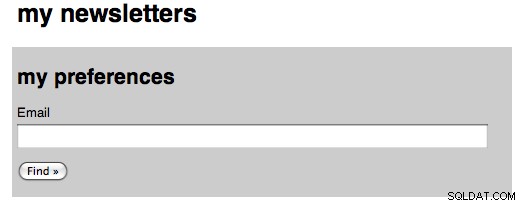

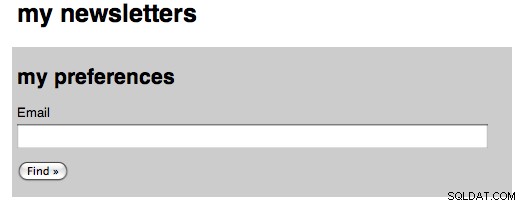
And the first looks like:
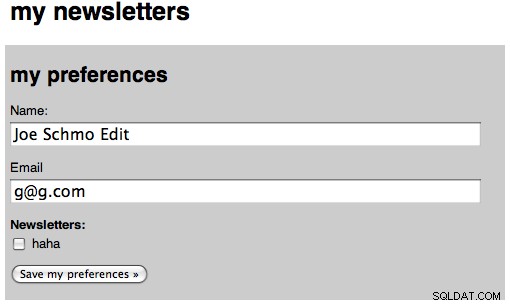

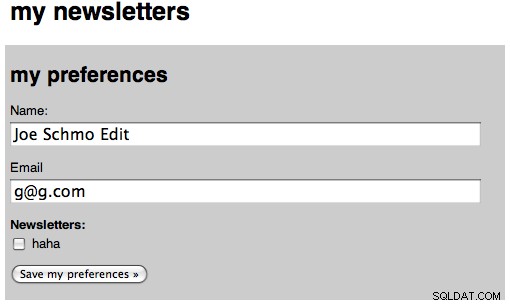
And the second form after we saved our preferences:
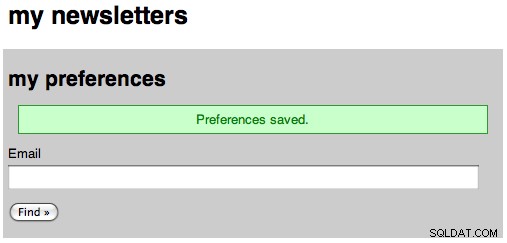

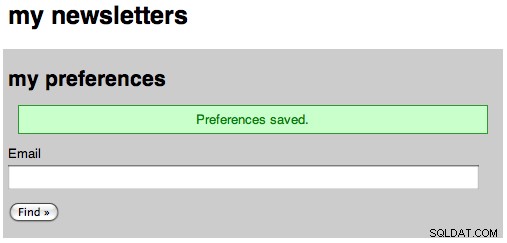
Now that we have finished the front-end, we have one last step:sending the emails!
Step 10:Sending Messages
Our last step is to work on the page to send our message. We will be working in the admin directory, and only one file will be created. Go ahead and create our messages_send.php file and place the following in it:
# admin/messages_send.php
<?php
require_once 'config.php';
login_required();
$title = "send message";
$id = (int) $_GET['id'];
$tab = 'mess';
if(isset($_POST['submitted'])) {
$query = "SELECT * FROM subscribers WHERE id=0 ";
$emails = array();
foreach($_POST['newsletter'] as $n) {
if($n['send'] == "true") {
$nlid = $n['nlid'];
$e = query("SELECT subscriber_id FROM subscriptions WHERE newsletter_id=$nlid");
foreach($e as $s) {
$sqlids .= " OR id=".$s['subscriber_id'];
}
$query .= $sqlids;
}
}
$subscribers = query($query);
foreach($subscribers as $sub) {
$emails[$sub['email']] = $sub['name'];
}
$from = array(FROM_EMAIL => FROM_NAME);
// BODY RENDERING
$mess = query("SELECT * FROM messages WHERE id=$id");
$message = $mess[0];
$subject = $message['subject'];
$tid = $message['template_id'];
$data = query("SELECT body FROM templates WHERE id=$tid LIMIT 1");
$template = $data[0]['body'];
if($message['rightcol'] == '') {
$leftcol = $message['leftcol'];
$body = str_replace('%content%', $leftcol, $template);
} else {
$leftcol = $message['leftcol'];
$rightcol = $message['rightcol'];
$b = str_replace('%leftcol%', $leftcol, $template);
$body = str_replace('%rightcol%', $rightcol, $b);
}
send_email_to_mass($from, $emails, $body, $subject) or die('lol');
header('Location: index.php');
}
$newsletters = query("SELECT * FROM newsletters");
foreach($newsletters as $nl) {
$nls .= '
<input type="hidden" name="newsletter['.$nl["id"].'][nlid]" value="'.$nl['id'].'" />
<input type="checkbox" name="newsletter['.$nl["id"].'][send]" value="true" '.$checked.'/>
<label for="newsletter['.$nl["id"].']">'.$nl['name'].'</label> - '.$nl['description'].'<br />
';
}
$mess = query("SELECT * FROM messages WHERE id=$id");
$message = $mess[0];
$subject = $message['subject'];
$content = <<<EOF
<a href="messages_preview.php?id=$id" class="large" target="_new">preview »</a><br />
<form action='messages_send.php?id=$id' method="POST">
<p>
Subject: $subject<br />
</p>
<p>Send to:<br />
$nls
</p>
<p>
<input type='submit' value='Send »' />
<input type='hidden' value='1' name='submitted' />
</p>
</form>
EOF;
include 'layout.php'; ?> The first part we again require our config, then make sure the user is logged in, then our title, make sure our id is an integer, and then set our tab. Next we have our complicated post block. First we set up our base query, and running just that would return 0 records, which is good because that means no users will be send the newsletter. Next we loop through every newsletter that we want to send to, and find all of the subscriptions for that newsletter. We then create a string that will be appended to our original SQL query so that we can find every subscriber. Now, we run that query and create an array where the keys are the emails and the name is the value, and this helps us use names when the user looks at the email in their mail application, showing the TO:as their name. We next find the message we are working with, and set the subject, message, and template id to variables. We then find our template and set the body to a variable. Then we use the same code from the message preview to replace the strings inside the template the the parts of the message. Then we call our yet-to-be-created-function send_email_to_mass and then redirect home.
Leaving our POST block, we create the same checkbox list of newsletters so the admin can pick which one(s) he wants to send the message to. Then we have a simple form that looks like:
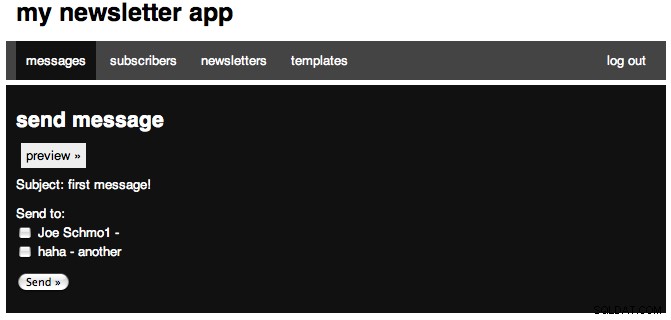
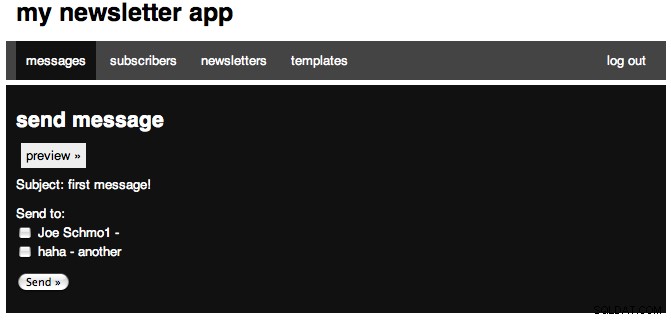
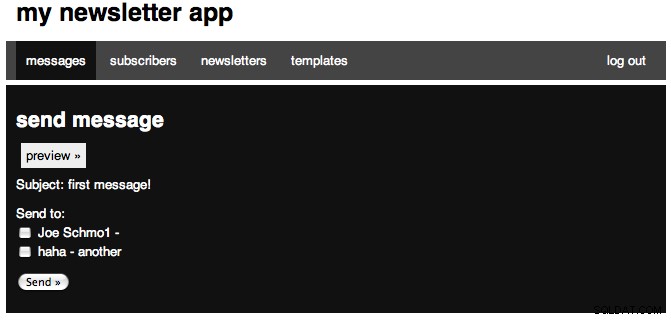
Now, open up our classes.php file and add the following function:
# admin/classes.php
// EMAIL
function send_email_to_mass($from, $recipients, $body, $subject) {
require_once 'swift/lib/swift_required.php'; //require lib
$transport = Swift_MailTransport::newInstance();
$mailer = Swift_Mailer::newInstance($transport) or die('Error creating mailer.');
$message = Swift_Message::newInstance($subject)
->setFrom($from)
->setTo($recipients)
->setBody($body, 'text/html') or die('error here.');
$result = $mailer->batchSend($message);
return true;
} So first, we have our function declaration, and it expects four variables to be passed to it, from, recipients, body, and subject. Next we require the sqift_required.php file of our Swift Mailer Library. Next we create a new Mail Transport (this uses the PHP mail function, so it would be sending from your local machine, for the documentation on the three transport types, see the documentation). Next we create a mailer using that transport. Then we create a new message from our subject, then set our from, to, and body. Then we use the batch_send function so that each recipient only sees themselves on the email, and no one else.
There is one possibly downside of doing it the way I have, and that is if you are sending many messages, the page may take forever to load. A solution to tthis would be running a Javascript AJAX request to send each and every message, but I won't cover that here. Now that we have finished working on sending messages, we are going to spice up the home page and then we will be done!
Step 11:The Homepage
When you load the admin index, the page does not really do much. I want to have some 'stats' on our homepage, and we will finally use the count_query function. Open up the admin index file and change it to look like:
# admin/index.php
<?php
require_once 'config.php';
login_required();
$users = count_query("SELECT COUNT(*) AS num FROM users");
$emails = count_query("SELECT COUNT(*) AS num FROM subscribers");
$subs = count_query("SELECT COUNT(*) AS num FROM subscriptions");
$nls = count_query("SELECT COUNT(*) AS num FROM newsletters");
$mess = count_query("SELECT COUNT(*) AS num FROM messages");
$temps = count_query("SELECT COUNT(*) AS num FROM templates");
$title = "Home!";
$content = <<<EOF
<h3>current stats</h3>
<p>$users user registered</p>
<p>$emails subscribers</p>
<p>$subs newsletter subscriptions</p>
<p>$nls newsletters</p>
<p>$mess messages</p>
<p>$temps templates</p>
EOF;
include 'layout.php'; ?> The page is very simple. We require our config, make sure we are logged in, then we perform six count queries, one for each of our tables and then output that. This is what the final page look like:
